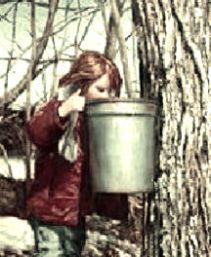Arlene Stafford-Wilson's Blog, page 22
March 9, 2023
Tatlock Memories
Darling township, Lanark County, with localities including Tatlock, White, and Marble Bluff, was named in 1822 for a military officer, Major General H. C. Darling. He was a colonel serving as the military secretary to Canada’s Governor General. Darling Township was surveyed in 1822 for the influx of Scottish lowland settlers, as well as former soldiers disbanded after the War of 1812 who would be given land grants in this area. Tatlock, is located in what was known as the ‘rocky north’ of Darling Township.
Historic Darling Township Post Offices
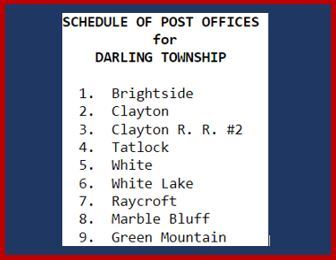
Tatlock, Lanark County
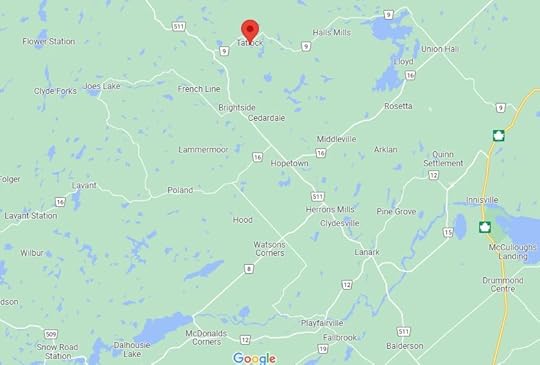
Google map – showing Tatlock and neighbouring communities
Tatlock Hall Opened – 1939
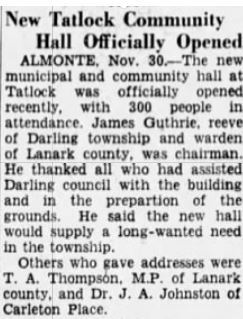
“The Ottawa Citizen”, Dec. 1, 1939, p. 7
The Tatlock Hall was built in 1850, originally a Presbyterian Church, near Brightside, on the French Line. By 1914 the church was closed.
In 1939 the building was torn down and rebuilt at Tatlock, to be used as a community hall. At the time, some believed that the cost to rebuild it, $300.00, would bankrupt Darling Township. Many years later, the hall was loaded onto a flatbed and moved again a short distance. Many upgrades and renovations have been added over the years, such as a new roof, insulation, a new kitchen, and decks off the washroom and kitchen.
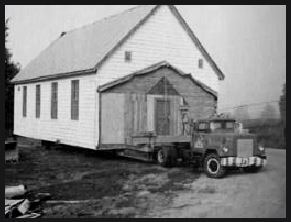
Tatlock Hall

Tatlock Community Hall

Festival of Small Halls concert, at the Tatlock Hall, in 2017
Tatlock Marble Mine

Omega Marble Tile and Terazzo, opened in April 1963, in Tatlock, Darling Township, Lanark County. High quality marble, named “Rideau Blue”, “Rideau White”, and “Princess Blue” was in great demand, and was used on many distinguished buildings of that time.

Some of the members of the original 1963 Omega crew: Steve Bennett, Clydesville, Bert Wark, Tatlock, Bernard Nichols, Calabogie, Bob Neilson of Clydesville, and Ivan Wark, Tatlock.
Beaton Family
Remains Discovered
During excavations at the Omega mines in 1963, several old graves were unearthed, containing the remains of a pioneer family: John Beaton, one of the early teachers and farmers in the area, along with his wife, Janet (Paton), daughter, Helen, son, Thomas, and an unnamed child, who likely died at birth.
The grave marker indicated that the mother, Janet Beaton, was buried in 1903, at the age of 83, so the family were believed to be early settlers to the area. Bob Neilson of Clydesville levelled off the grave at the Omega mine, and the families remains were moved to the Hopetown Cemetery, where a gravestone was erected in their memory.

Families of Tatlock
Some of the early families of Tatlock: GUTHRIE, SCHAULER, CRAIG, FAY, RINTOUL, GUNN, WARK, CALDWELL, BARR, BUFFAM, MCILRAITH, MURRAY, CAMELON, MCDOUGALL, SMITH, FLEMING, SWEENEY, STEWART, BURNS, CRAWFORD, MAJAURY, BETELL, BEATON, RAYCROFT, PRETTY, TRAILL, JORDAN, LALONDE, LAROQUE, MAJORE, FOY, CARDINAL, RANGER, PERRY, MCFARLANE, BALLANTYNE, ELLIOTT, CAMELON, FRANK, VIRGIN, BRADFORD, LEE, PENMAN, KING, RABB, LANGSTAFF, WATT, BLACK, MUNRO, MCGEE, MCNEIL, LETT, PROCTOR, KILGORE, MCINTYRE, ROBERTSON, ABRAM, BOYLE, KINGSTON, SMITHSON, SPINKS, ROYCE, BARRIE, RING, MANARY, WHITE.

Arlene Stafford-Wilson
Member, Association of Professional Genealogists
Honorary Life Member, Lanark County Genealogical Society
Author of : “Lanark County Christmas”, “Lanark County Comfort”, “Lanark County Collection”, “Lanark County Calling”, “Lanark County Classics”, “Lanark County Connections”, “Lanark County Calendar”, “Lanark County Chronicle”, “Lanark County Kid”, & “Recipes & Recollections”
available at local stores or email: lanarkcountybooks@gmail.com
March 8, 2023
Spring Came Up the Third Line
One of my friends from DeWitt’s Corners said that they’d seen a robin in their back yard, but I hadn’t seen one yet. The only sign of spring that I’d noticed was the steady drip of water, coming off of the old roof, in the late afternoons, when I returned home from Glen Tay School. That meant that the temperature was rising above freezing during the day, so the sap must be running again.
Sure enough, that same day, I saw Dad heading down the lane, toward the Third Line, and he had his carpenter’s auger in his hands. That old thing looked battered and ancient, but it sure did the trick when he needed to tap some trees. We didn’t have a big maple bush like Korry’s, across the road, but Dad always tapped a few trees along the laneway, so that we’d have enough syrup for the family.
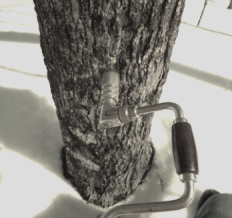

If anyone had bothered to stroll past the trees that we’d tapped, they likely would have laughed themselves silly. It wasn’t exactly a professional operation. None of the buckets matched. We had a grey metal pail, that hung on one of the spiles by a rusty wire. We also had a white plastic bucket, that Mother had made, by cutting up an empty corn syrup jug. Another bucket was made from an empty Billy Bee honey container. We even used one of my old sand pails, that I’d played with on the beach, when we went to Silver Lake in the summer. Any available container was ‘fair game’. It was only for a few weeks after all, and they couldn’t afford to be spending money on something that was used for such a short period of time each year.
Looking back, it didn’t really matter what kind of buckets you used, as long as you had something to collect the sap. I used to stand at the side of the tree, and watch as the clear, sweet liquid dripped ever so slowly, drip, drip, and splashed into the bucket below. I’d lift the bucket off of the metal hook, and dump the sap into Mother’s biggest mixing bowl, hook the bucket back on the tree, and carry the bowl gingerly up the lane way, and into the kitchen. Mother would be ready with a piece of clean cheesecloth, stretched over the big aluminum pot on the stove, and she’d take the bowl of sap, and dump it into the pot. The cheesecloth would catch all of the little specks of dirt, or bits of wood, that had come from the tree, so that the sap in the pot was nice and clean.
I guess if I’d been a little older, and a lot smarter, I would have asked Dad for one of the big pails from the garage, to transport all of the sap, in one trip, into the kitchen. Instead, I emptied one bucket at a time, into the big mixing bowl, and trekked all the way back and forth, up to the kitchen. Up the lane, and down the lane, I went over and over again, until I was finished; usually just before supper time. One night I forgot to empty the buckets, and the next night the sap was overflowing, running down the side of the tree, onto the snow. No one said anything about it, but I felt bad because I hadn’t done my job, and worse still we’d have less syrup because of it.
The air in the old kitchen smelled sweet for those few weeks each year, as the sap boiled away on top of the stove. Usually by the third or fourth day we’d have enough for a little bowl of syrup for dessert. The first syrup of the year was always the lightest in colour and in flavour, perfect for eating straight out of the bowl. Dad liked to pour a little cream into his syrup, and give it a stir. He’d take a piece of day-old homemade bread and dip it into his creamy syrup mixture, until he was down to the last sweet drops, and then he’d do one last sweep of the bowl with his bread.
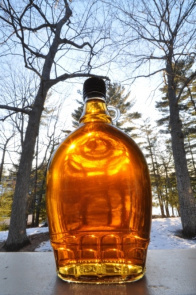
The other kids in the family poured their syrup over vanilla ice cream, but I liked mine straight-up, with nothing getting in between me and that sweet, perfect, maple flavour. I’d take a melamine bowl and teaspoon out of the old sideboard, pour myself a little, and enjoy it just like that.
As the weeks passed by, the syrup became darker in colour, and the flavour grew richer, and more intense. It was like magic watching the syrup change from a light honey colour to the rich, dark, amber toward the end of the run. The sap dripped slower and slower from the trees, as the days grew longer and warmer. When I waited for the big orange school bus to chug up the Third Line, it wasn’t as dark outside, nor as cold, in the early mornings,
The sun was shining a little brighter each week, and our driveway became a soggy obstacle course, as we stepped around the growing puddles of water. The snow banks finally shrunk, and shriveled away. Soon after, we’d take the buckets down, and put them away in the back porch for another year. Dad removed the spiles from the maple trees, wrapped them in a soft cloth, and placed them in the top drawer of his tool chest in the garage.
By then, the maple trees were beginning to bud, and a few of the familiar spring birds were returning to Mother’s bird feeder, in the back orchard. Almost all of the snow had shrunk down to a few dirty white mounds, spaced here and there in the yard, and the ground was spongy, cold and brown. The sun grew a little brighter each day, and stayed up in the sky later and later, after supper each night.

The warm weather wasn’t here yet, not even close; but all the signs were there that it was just around the corner. Each year when we tapped those maple trees, I knew that spring was not far away. It was only a matter of time now that she’d be coming up the Third Line, with all of her delicate shades of green. She’d be bringing her warm sun, and her gentle breezes. She’d slip into our yard quietly one morning, and tell all of the flowers to wake up, and show their colours. She’d whisper to the squirrels and the chipmunks, and invite them to come back and play in our yard.

I often wondered if spring could see us tapping our trees, and if that was her signal to make her way back into Lanark County, and into our yard. Maybe there was something magical about the syrup, and once we’d had our first taste, Old Man Winter knew that it was time for him to pack up his snow, and his cold winds, and head up north. Either way, we always knew that as soon as the sap began to run we’d be seeing spring in all of her glory in no time at all!
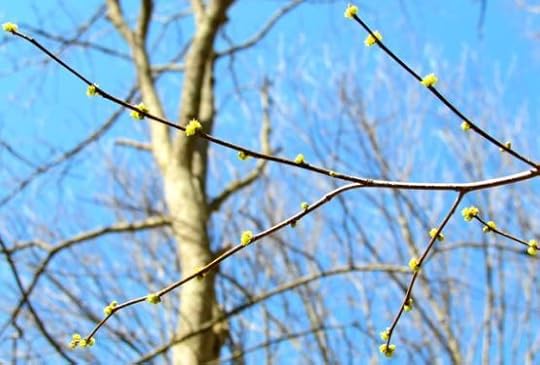
Sweet memories among the maples!

Arlene Stafford-Wilson
Member, Association of Professional GenealogistsHonorary Life Member, Lanark County Genealogical SocietyAuthor of : “Lanark County Christmas”, “Lanark County Comfort”, “Lanark County Collection”, “Lanark County Calling”, “Lanark County Classics”, “Lanark County Connections”, “Lanark County Calendar”, “Lanark County Chronicle”, “Lanark County Kid”, & “Recipes & Recollections”available at local stores or email: lanarkcountybooks@gmail.comMarch 7, 2023
Maple Syrup: 10 Things You May Not Know
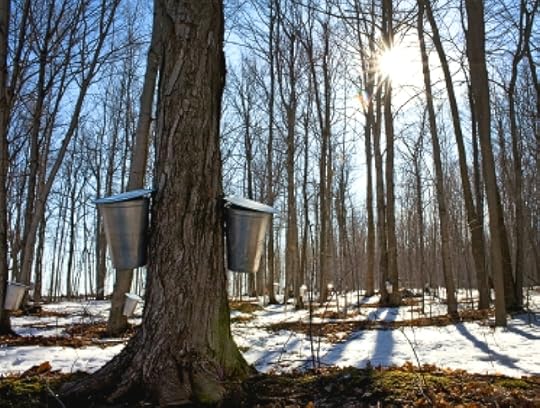
1. It is not a coincidence that Canada has a maple leaf on the nation’s flag. Canadians produce 85% of the world’s maple syrup.

2. The highest quality maple syrup is found in Lanark County, also known as the “Maple Syrup Capital of Ontario”. Lanark County is located in Eastern Ontario, Canada between the cities of Kingston and Ottawa. The historic town of Perth is the county seat, and hosts an annual maple festival each year featuring award-winning maple vendors.

3. Maple syrup is naturally ‘Organic’, because it is produced from natural trees in a wild environment.
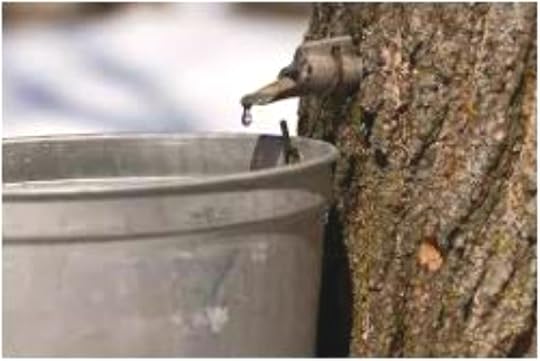
4. Maple syrup has tremendous health benefits. This natural sweetener contains over 54 antioxidants that may help delay or prevent diseases caused by free radicals such as cancer or diabetes. Pure maple syrup has the same beneficial antioxidants found in berries, tomatoes, green tea, red wine and flax seeds.
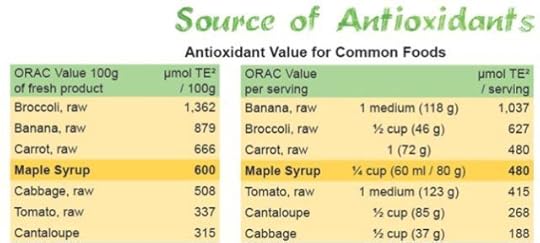
5. A tablespoon of maple syrup has only 40 calories, versus honey with 64 or corn syrup with 60. Maple syrup contains more calcium than milk and more potassium than bananas.

6. Long before the Europeans arrived in North America, natives were collecting sap from maple trees, heating it in hollow logs until it was syrupy, and called it ‘sweet water’.

7. The sap which runs from the ‘tapped’ maple tree is 97 percent water, and forty gallons are evaporated to make one gallon of syrup.
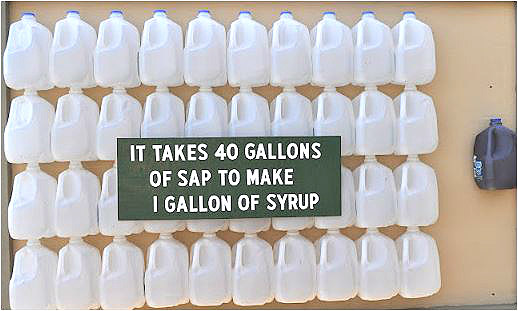
8. A maple tree is normally 30 years old and 10 inches in diameter before it is tapped. As the tree increases in diameter a maximum of four taps can be put into the tree. The tree is not damaged from the tapping process.

9. Maple syrup is graded according to colour and flavour. Lighter syrup is produced earlier in the season when it is colder. As the weather warms up the syrup becomes darker, with a more robust flavour.
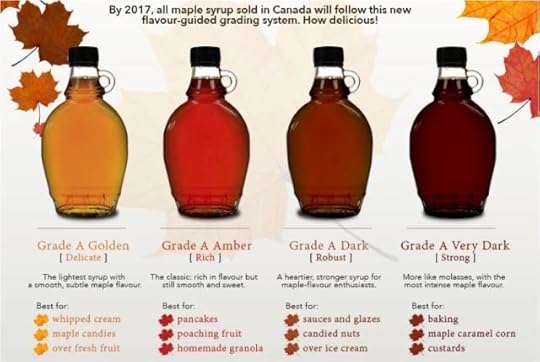
10. Warm spring days with temperatures above freezing, and cold nights below freezing is ideal weather for maple syrup production. The season varies, but normally lasts four to eight weeks depending on the weather.

………
Discover some of the finest maple syrup in the world at the yearly maple festival held in Perth, Ontario – in the heart of Lanark County.

…….
For details on the nutritional benefits of pure maple syrup: Powerful Antioxidants in Maple Syrup
…….
Easy, mouth-watering recipes for Maple Butter and Maple Fudge at the conclusion of this article.
Contact information listing vendors known for their premium quality maple syrup; many are award winners:Fulton’s Pancake House and Sugar Bush
Address: 291 6th Conc Rd., Pakenham, On
Phone: 613-256-3867 Email: info@fultons.ca Website: http://www.fultons.ca
McFarlane’s Maple Syrup
Grant & Gail McFarlane
1550 Prestonvale Rd
Lanark, ON K0G 1K0
Phone – 613-259-5410
Email – grantandgail@storm.ca
Fortune Farms
Jamie Fortune
2442 Wolf Grove Rd., Almonte, ON
(613) 256-5216
info@fortunefarms.ca
Paul’s Maple Products
Nathan Paul
267 Sugar Bush Way,
Lanark, ON K0G 1K0
Phone – 613-259-5276
Email – info.paulsmapleproducts@gmail.com
Coutts Country Flavours
Address: 1230 Port Elmsley Rd. RR5 Perth, Ontario K7H 3C7
Phone: 613-267-0277
Website: https://couttsmaple.com
Jameswood Maple
3231 Wolf Grove Road
Dwight James
249 Purdy Rd,
Lanark, ON K0G 1K0
Phone – 613-256-4466
Email – jameswood@storm.ca
website: https://jameswoodmaple.ca/
Temple’s Sugar Camp
Address: 1700 Ferguson’s Falls Rd. Lanark, On
Phone: 613-253-7000 Email: info@templessugarbush.ca
Website: http://www.templessugarbush.ca/
Dorian Heights Maple Products
3631 Watsons Corners Rd,
RR 1 McDonalds Corners, ON K0G 1M0
Phone – 613-278-2177
Springdale Farm
Stephen Dodds
Home – 1790 Galbraith Rd, RR 2
Clayton, ON K0A 1P0
Sugar Shack – 1699 Galbraith Rd.
Clayton, ON K0A 1P0
Phone – 613-256-4045
Email – info@springdalemaple.ca
Web site – http://www.springdalemaple.ca
Thompsontown Maple
info@thompsontownmaple.ca
613-256-1826
780 Black Rock Lane,
Clayton, Ontario KOA 1P0
Fairbairn Farm
1827 Wolf Grove Rd,
Almonte, ON K0A 1A0
Phone – 613-256-5047
Web site – http://www.fairbairnmaple.com
Wheeler’s Pancake House & Sugar Camp
Address: 1001 Highland Line Lanark Highlands (McDonalds Corners), On
Phone: 613-278-2090 Email:webinfo@wheelersmaple.com Website: http://www.wheelersmaple.com
(Wheelers Pancake House and Maple Sugar Camp, has also gained worldwide recognition for achieving the Guinness World Record for “largest collection of maple syrup production artefacts.” In 2000, the collection opened to the public at Wheelers Maple Heritage Museum, and on Jan. 17 the collection of 5,228 items earned the Guinness World Record. The artefacts include 1,325 maple sap spouts, 507 maple sugar molds, 694 maple syrup serving jugs, 100 Native sugaring artefacts, 37 syrup dippers and 263 sap buckets.”
Ennis Maple Products Ltd
848 Ennis Rd,
Balderson, ON K0G 1A0
Phone – 613-267-3491
Email – ennismaple@gmail.com
Web site – http://www.ennismaple.com
VanAlstine Maple Products
Mark and Kathy VanAlstine
472 Maberly Elphin Rd, Maberly, ON K0H 2B0
613-812-0334
kathyvanalstine@hotmail.com
Ryan & Glenn Stead
5692 Hwy 511,
Lanark, ON K0G 1K0
Phone – 613-259-2704
Email – steadmaplesyrup@gmail.com
President’s Awards to Bryan Exley, Don Dodds and the Chant Family
……….
Jeremy Adams – Maple Products and Firewood Sales, McDonald’s Corners 613-278-0082
……….
Oliver’s Mapleworks
Located at 158 Lakewood Lane, Perth, Ontario K7H 3C7. http://www.oliversmapleworks.com
Email: tree.mapleworks@gmail.com
Phone: 613-264-8612.
Grand Champion Winner 2016 at Perth Festival of the Maples
……..
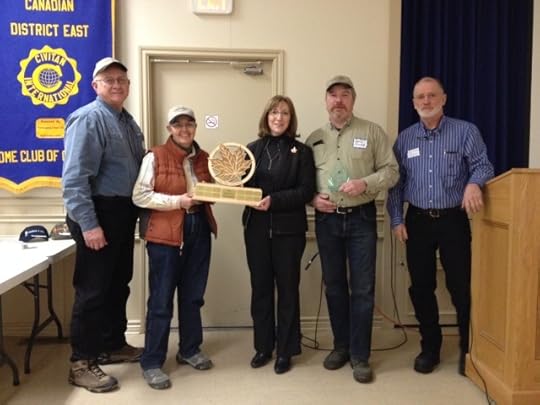
….
2017 Award Winners
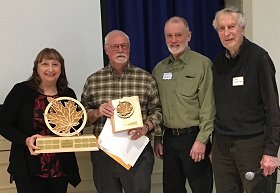
(presented by Dwight James and Ray Fortune)
………………………………………………………………………………………………………………
Lanark & District Maple Syrup Producers Association2018 Sugar Maker of the Year Award:Dwight James(presented by Harold Walker, LDMSPA President)
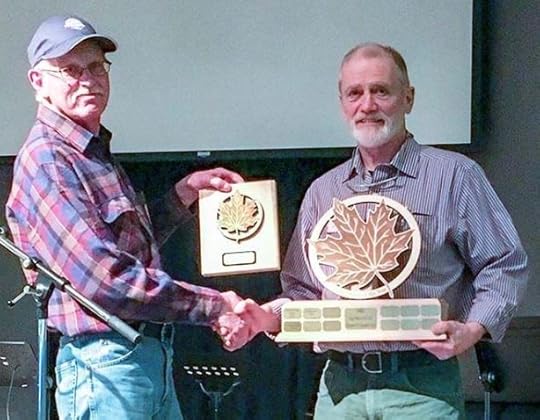
2018 – Dwight James
2017 – George and Linda Horton
2016 – Tressa and David Oliver
2015 – Wheeler Family
2014 – Charlie Temple
2013 – David & Paul Chant
2012 – Ray Thompson
2011 – Bill Gibbons
2010 – Don and Marion Dodds
2009 – Ray Fortune
2008 – George Ennis
2007 – Marion Paul
…….
Two of our family’s favourite Maple Recipes:Maple Butter

Ingredients:
• 1/2 cup softened butter
• 1/4 cup maple syrup
Preparation Time 5 minutes:
Mix butter and maple syrup with electric mixer until blended. Serve on toast, cracker or warm muffins. This is so tasty, and could not be easier to make. Use this creamy maple butter spread on bread, pancakes, muffins, toast, and biscuits.
Yield: about 3/4 cup
……………………………………………………………………………………………………………………………………..
Maple Cream Fudge
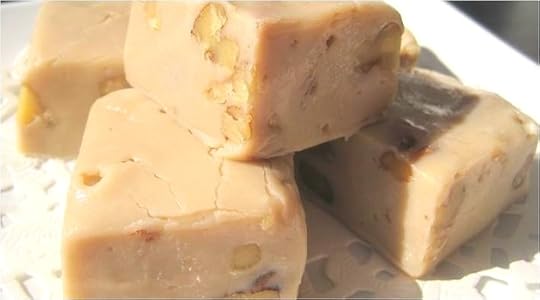
1 cup white sugar
1 cup brown sugar
1 cup cream (I use Heavy cream/whipping cream)
1/3 cup of butter
1/4 cup of maple syrup
pinch of salt
vanilla
Add the two sugars, butter and cream, maple syrup, and salt into a sauce pan. Place over medium heat. Stir while bringing to a boil. Lower the heat and continue to stir slowly while the mixture cooks. After about 7 minutes, test by pouring a small amount into some cold water. You want it to form a soft ball. You might need to cook it for another minute or two. Remove from the heat, add a couple of teaspoons of vanilla and start stirring. It takes about 14 or 15 minutes for the fudge to cool and thicken. Pour into buttered dish. TIP: If you let the fudge sit for 10 minutes after removing from the heat and allow it to cool slightly this will reduce the stirring time. Option: Replace the cream and cup of white sugar with one can of Sweetened Condensed Milk and increase the maple syrup to 1 cup
….
Whether you prefer maple fudge, maple taffy, or maple syrup ‘straight-up’, take some advice from this Lanark County ‘kid’, and enjoy the unforgettable tastes of our spring harvest – all year ’round!
…………………………………………………………..
photo credit: maple bush – Jane Southren…………………………………………………………………..
To discover more about the history and local maple producers in Lanark County, “Lanark County Chronicle” features a chapter ‘Taffy on the Tay’, recalling the ‘good old days’ of maple syrup production.
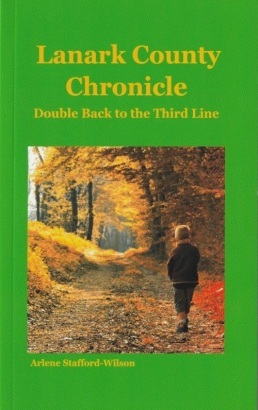
Arlene Stafford-Wilson
Member, Association of Professional GenealogistsHonorary Life Member, Lanark County Genealogical SocietyAuthor of : “Lanark County Christmas”, “Lanark County Comfort”, “Lanark County Collection”, “Lanark County Calling”, “Lanark County Classics”, “Lanark County Connections”, “Lanark County Calendar”, “Lanark County Chronicle”, “Lanark County Kid”, & “Recipes & Recollections”available at local stores or email: lanarkcountybooks@gmail.com
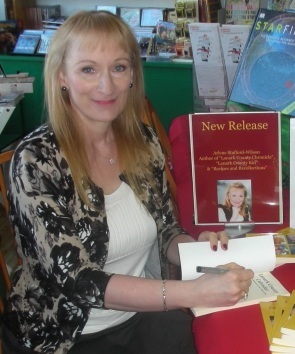
Arlene Stafford-Wilson
March 2, 2023
Perth Library – Heart of the Town
Although there was a reading room established on the main street of Perth in the 1800s, which featured current newspapers, books and periodicals, it wasn’t until the beginning of the twentieth century that a formal library building was constructed.
With the help of a large donation from the Andrew Carnegie Foundation, along with municipal and private funds, a library was built and opened to the public on Dec. 30th,1907.
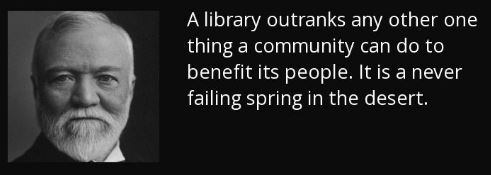
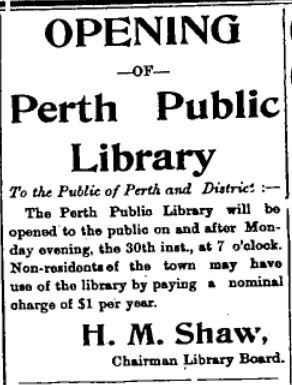
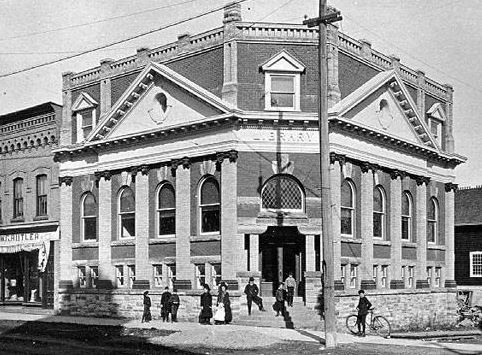
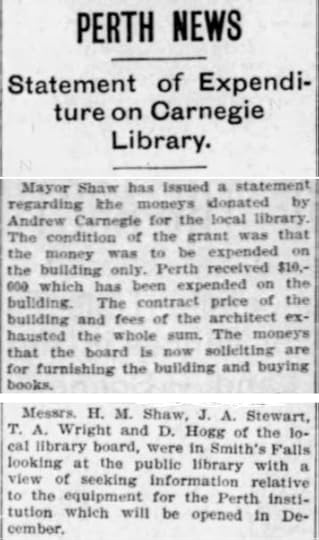
The Perth Library was one of five libraries in Ontario that was built using grants from American philanthropist Andrew Carnegie. Constructed from local rock and brick, the library was an impressive three story building gracing Gore Street near the Tay River canal.
No Smoking Rule – Jan. 1908
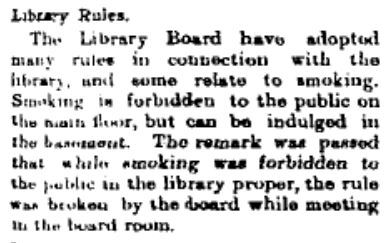
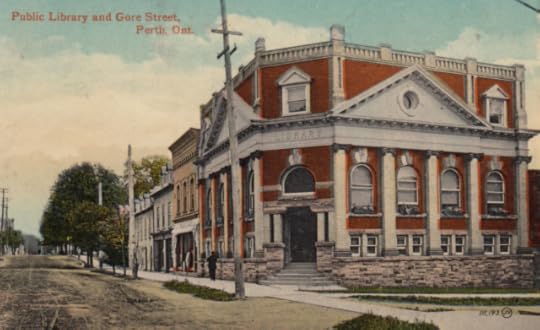
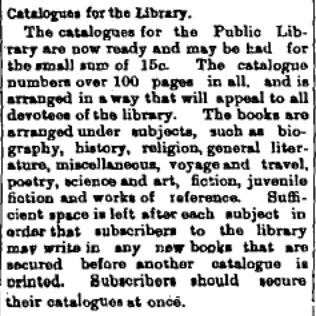
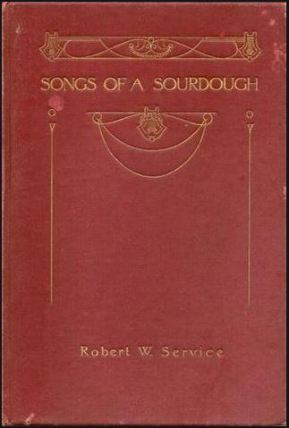

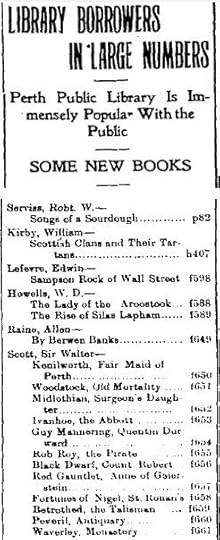

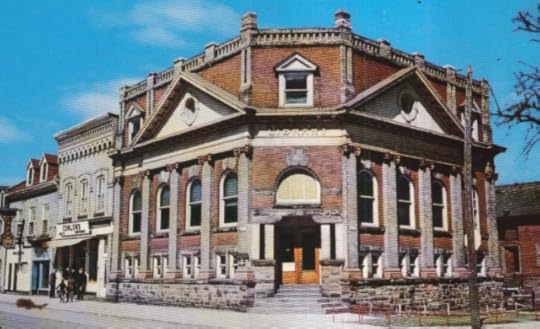
At at 7:15 p.m on Thursday, January 3rd, 1980, flames tore through the building. It was said at the time that the fire likely began in the basement.
“Shaking their heads in disbelief, Perth’s residents, both young and old, gazed yesterday at the gutted remains of their historical public library.”For over four hours a team of about 50 fire-fighters fought in freezing temperatures, and poured thousands of gallons of water into the building, through smashed windows and doorways.
Perth police constable, Bob Carnrite, said, “The cause of the fire is a mystery.”Water soaked books smoldered in the gutted building and nothing could be saved. Over 62,000 books along with paintings, antiques, maps and historical documents were lost.
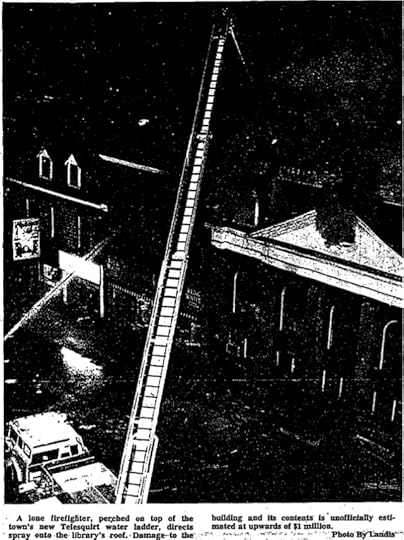

I recall the eerie sight of the building, familiar to so many of us, appeared like an ice castle because of the frigid temperatures, and the tremendous amount of water used to fight the fire.
“Every child is talking about it today.”, said Eve Dodge, Supervisor of the Perth Daycare Center. “Because of all the programs held there and their frequent contact, the library was a very important part of their lives.”It was a devastating loss to the town of Perth having been one of the loveliest buildings on the main street for so many decades.
“For this town, the library was the heart of the community.”It also meant job loss for Assistant Librarians, Susan Mackey, and Fay Cunningham.
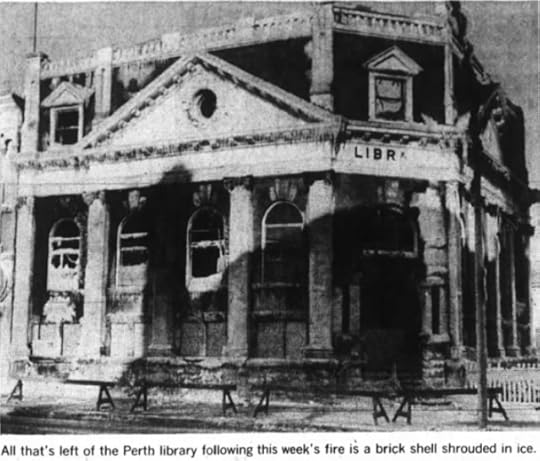
Harold Jordan, Inspector withe the Ontario Fire Marshall’s Office visited the site once the blaze was extinguished, and sifted through the ruins.
“I haven’t formed any conclusions yet”, Jordan said, “I’m considering every possibility. There are some indications the fire may have started in the basement, but I have no information at the moment which points the cause at anything other than accidental. Our minds are still open.”The inspection showed that no fuses in the library had blown, and that the fire had started in the basement.
Secretary Treasurer, Ivey Mather, said, the investigation continues….The Perth Public Library Board immediately began to find a temporary location for a public library.
The Board was offered space above the River Guild, and at St. James’ Hall, and even at the old Bell Telephone building.
“We could be back into circulation by next week.”, said Board Chairman, Bernard Elliot.
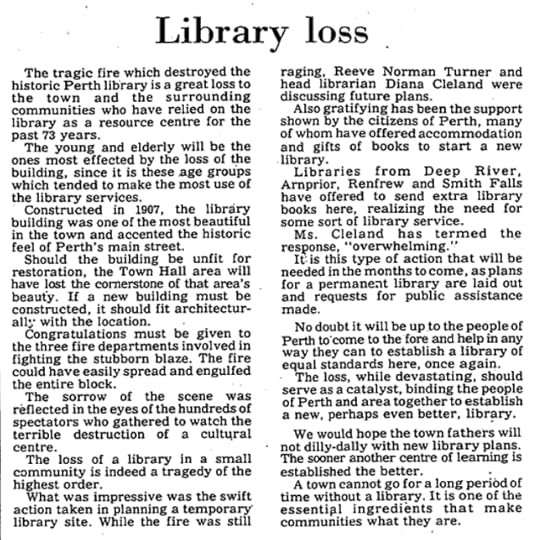
Other local libraries donated books and these were housed temporarily in the basement of McMartin House, and plans were quickly put into place to establish a new library.

The present library, on the corner of Herriott and Drummond Streets, was opened on December 16th, 1981.
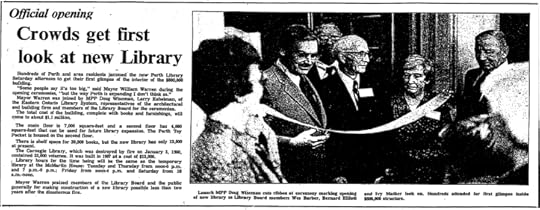
Photo: Lanark MPP Doug Wiseman cuts the ribbon. Library Board Members: Wes Barber, Bernard Elliot, and Ivy Mather.
The new building was constructed, at a total cost of $800,000.
(the original library in 1907 was built for $13,000)
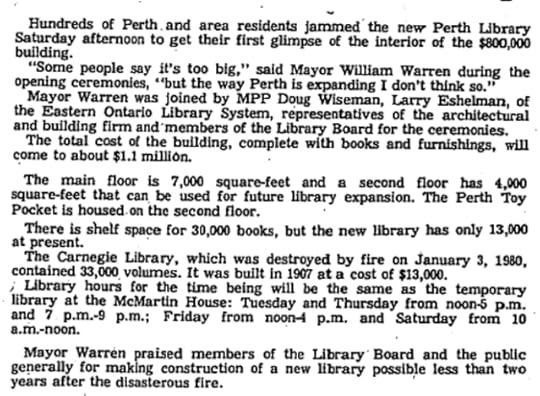
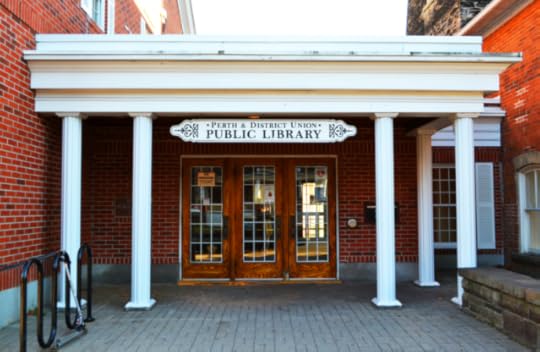
The ‘new’ Perth library is located at 30 Herriott St, Perth, Ontario – a beautiful setting, along the Tay River.
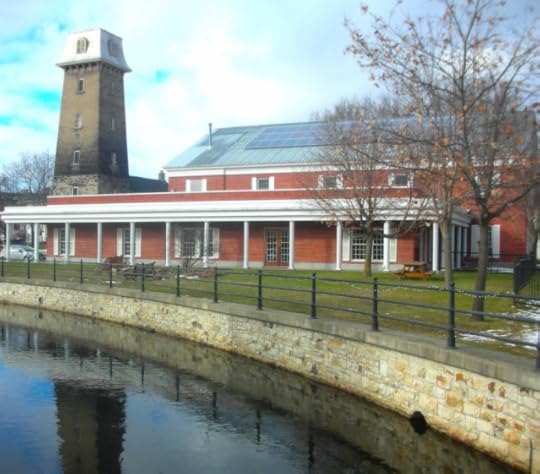
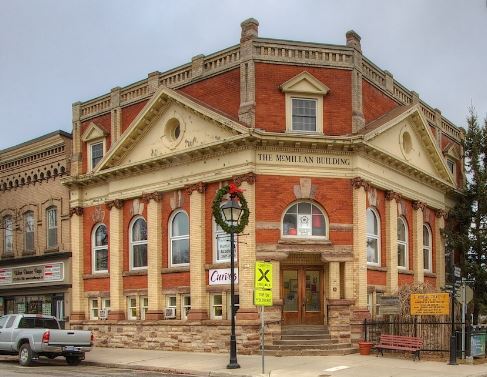
For more information on the history of the Perth Library:
“Meet the dedicated staff of the Perth Public Library, who worked there in the 1960s, 1970s, 1980s, and beyond. Discover the tragedy, scandal, and unstoppable spirit that made this place ‘the heart of the town’.”
The story, “Perth Library: Heart of the Town”, is one of the stories in –
“Lanark County Collection: Winding Our Way Down Memory Lane”
(available at The Book Nook in Perth, Ontario, Spark Books & Curios Perth, Ontario, and Mill Street Books in Almonte, Ontario)
…………
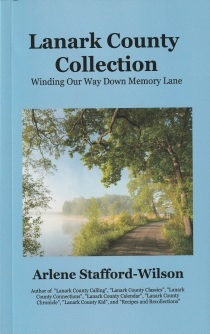
Arlene Stafford-Wilson
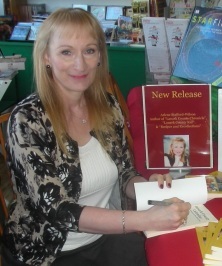
Although there was a reading room established on the main street of Perth in the 1800s, which featured current newspapers, books and periodicals, it wasn’t until the beginning of the twentieth century that a formal library building was constructed.
With the help of a large donation from the Andrew Carnegie Foundation, along with municipal and private funds, a library was built and opened to the public on Dec. 30th,1907.




The Perth Library was one of five libraries in Ontario that was built using grants from American philanthropist Andrew Carnegie. Constructed from local rock and brick, the library was an impressive three story building gracing Gore Street near the Tay River canal.
No Smoking Rule – Jan. 1908








At at 7:15 p.m on Thursday, January 3rd, 1980, flames tore through the building. It was said at the time that the fire likely began in the basement.
“Shaking their heads in disbelief, Perth’s residents, both young and old, gazed yesterday at the gutted remains of their historical public library.”For over four hours a team of about 50 fire-fighters fought in freezing temperatures, and poured thousands of gallons of water into the building, through smashed windows and doorways.
Perth police constable, Bob Carnrite, said, “The cause of the fire is a mystery.”Water soaked books smoldered in the gutted building and nothing could be saved. Over 62,000 books along with paintings, antiques, maps and historical documents were lost.


I recall the eerie sight of the building, familiar to so many of us, appeared like an ice castle because of the frigid temperatures, and the tremendous amount of water used to fight the fire.
“Every child is talking about it today.”, said Eve Dodge, Supervisor of the Perth Daycare Center. “Because of all the programs held there and their frequent contact, the library was a very important part of their lives.”It was a devastating loss to the town of Perth having been one of the loveliest buildings on the main street for so many decades.
“For this town, the library was the heart of the community.”It also meant job loss for Assistant Librarians, Susan Mackey, and Fay Cunningham.

Harold Jordan, Inspector withe the Ontario Fire Marshall’s Office visited the site once the blaze was extinguished, and sifted through the ruins.
“I haven’t formed any conclusions yet”, Jordan said, “I’m considering every possibility. There are some indications the fire may have started in the basement, but I have no information at the moment which points the cause at anything other than accidental. Our minds are still open.”The inspection showed that no fuses in the library had blown, and that the fire had started in the basement.
Secretary Treasurer, Ivey Mather, said, the investigation continues….The Perth Public Library Board immediately began to find a temporary location for a public library.
The Board was offered space above the River Guild, and at St. James’ Hall, and even at the old Bell Telephone building.
“We could be back into circulation by next week.”, said Board Chairman, Bernard Elliot.

Other local libraries donated books and these were housed temporarily in the basement of McMartin House, and plans were quickly put into place to establish a new library.

The present library, on the corner of Herriott and Drummond Streets, was opened on December 16th, 1981.

Photo: Lanark MPP Doug Wiseman cuts the ribbon. Library Board Members: Wes Barber, Bernard Elliot, and Ivy Mather.
The new building was constructed, at a total cost of $800,000.
(the original library in 1907 was built for $13,000)


The ‘new’ Perth library is located at 30 Herriott St, Perth, Ontario – a beautiful setting, along the Tay River.


From its early days, beginning in 1907, with the first librarian, Hattie Nicoll, the Perth Library has served the community and surrounding rural areas. With its rich history, along with the innovation and evolution of new technology, the library continues to serve its patrons, today, and into the future.
For more information on the history of the Perth Library:
“Meet the dedicated staff of the Perth Public Library, who worked there in the 1960s, 1970s, 1980s, and beyond. Discover the tragedy, scandal, and unstoppable spirit that made this place ‘the heart of the town’.”
The story, “Perth Library: Heart of the Town”,“Lanark County Collection: Winding Our Way Down Memory Lane”(available at The Book Nook in Perth, Ontario, Spark Books & Curios Perth, Ontario, and Mill Street Books in Almonte, Ontario)…………

Arlene Stafford-Wilson

February 28, 2023
Mother’s Farmhouse Date Squares
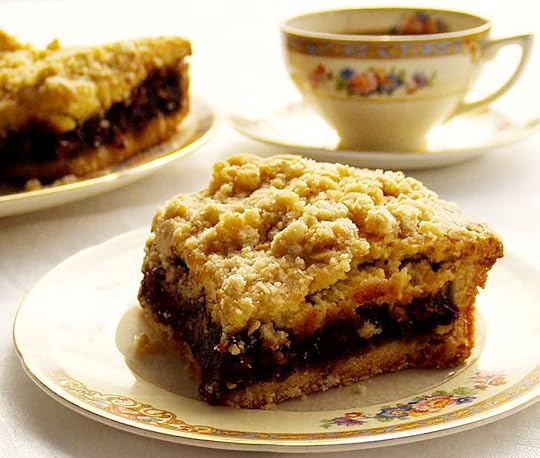
Date Squares or
Matrimonial Cake?
We know it as ‘Date Squares’ in Ontario, but in western Canada it’s called ‘Matrimonial Cake’.
There are a few different theories as to the origins of the name ‘Matrimonial’, and some say the meaning is as simple as the symbolism of the two layers of crumbly oats joined together as one by the date filling.
A Wedding Favour
At one time Matrimonial Cake was given as a wedding favour in the west, wrapped in plastic, then in a paper doily, tied with a ribbon, and left at the table for each guest.

The Dirty Thirties
The popularity of this cake peaked during the 1930s and 1940s. Mother always referred to the Great Depression years as, ‘The Dirty Thirties’. They were difficult economic times with high rates of unemployment, and a long-running drought in the Prairies known as ‘the Dust Bowl’. By the early 1930s, over one third of the labour force was unemployed, and in rural areas of the west almost two thirds of the population were on an early form of welfare known as ‘relief’. Matrimonial cake became a low-cost alternative to more expensive wedding cakes. In the days of coal fired or wood stoves and their uneven heating it was the one type of cake that wouldn’t ‘fall’ and lose its shape in the oven.
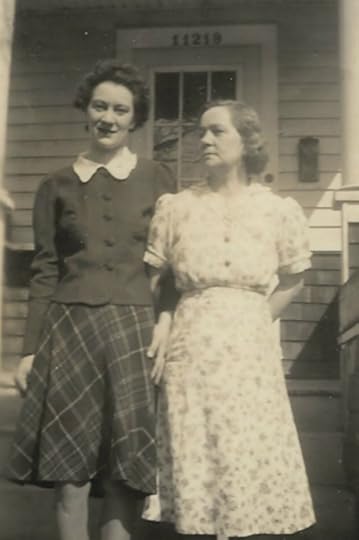
‘Mother’ – Audry Rutherford Stafford with her mother, ‘Granny’ Dorothy Woolsey Rutherford in front of their home in Edmonton, 1936.
Rationing and the War Years
In the 1940s, the cake’s popularity surged once again; this time for different reasons. Food was being shipped to our soldiers, and also being sent to Britain for our allies. More than half of all wheat and flour consumed in Britain during WWII was sent from Canada, along with more than a third of their bacon, a quarter of their cheese, eggs, and evaporated milk.
Sugar was the first staple food to be rationed in Canada in 1942, followed by coffee and tea a few months later, and butter by the end of the year. In 1943, the government began to ration meat.
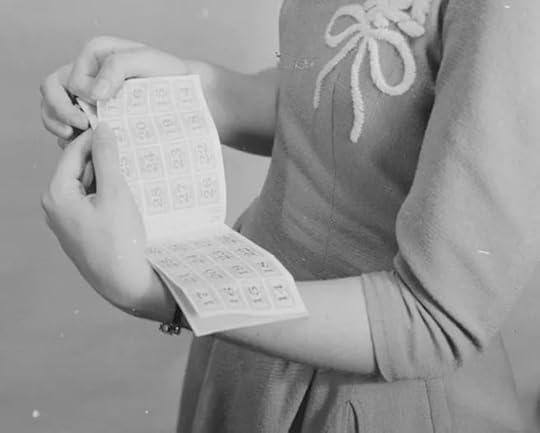 Ration book – 1943
Ration book – 1943
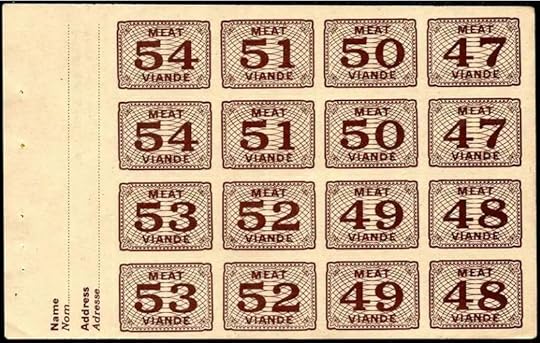
Ration coupons from a ration booklet 1940s – Canada
A Popular Alternative
to Wedding Cake
Matrimonial cake became a popular alternative to traditional cakes which required white sugar, eggs, and butter. In those days shortening was used in place of butter in many recipes. Cooks and bakers had to be creative by necessity, as there were no packaged or fast foods in those days.
After WWII, Dad returned to Canada, from his posting overseas in Bournemouth, England. Mother had been staying with her parents in Edmonton. By the time they moved to Lanark County in 1947, to live with Dad’s aunt and uncle, Mother had been making her Matrimonial Cake for years, and had perfected her recipe.

Stafford House, 1947, Tay Valley Township, Lanark County
In the years that followed, Mother’s Matrimonial Cake would become a family favourite. Like many of her recipes, it was a prize-winner, many times over, at the local fairs.


Audry Rutherford Stafford at Stafford House, 1964
Date Squares
Matrimonial Cake
1 3/4 c oats
1 c flour
1 c brown sugar
1 tsp salt
1/2 tsp baking soda
3/4 c softened butter or shortening
Date filling:
1 lb of diced pitted dates
3 Tbsp brown sugar
1 tsp vanilla
1 1/4 c boiling water
Mix dry ingredients together and press half in the bottom of a square pan
Cook filling until smooth and spread over crumb mixture
Add remaining dry ingredients and pat down firmly
Bake at 375 for 25-30 minutes

Whether you call them Date Squares, or, know it as Matrimonial Cake, as they do in the Canadian west, it’s a nutritious snack, rich with vitamins and minerals, and were always a popular treat at the Stafford house.
Enjoy!
Recipe from: “Recipes and Recollections: Treats and Tales from Our Mother’s Kitchen”

Books available at The Book Nook, and The Bookworm, Perth, Mill Street Books, Almonte,
and lanarkcountybooks@gmail.com

Arlene Stafford-Wilson
Member, Association of Professional Genealogists
Honorary Life Member, Lanark County Genealogical Society
Author of : “Lanark County Christmas”, “Lanark County Comfort”, “Lanark County Collection”, “Lanark County Calling”, “Lanark County Classics”, “Lanark County Connections”, “Lanark County Calendar”, “Lanark County Chronicle”, “Lanark County Kid”, & “Recipes & Recollections”
February 23, 2023
St. John’s Anglican, Innisville
The earliest services for St. John’s Church, Innisville were conducted in a rustic log building built in 1854, at Boyd’s Corner, shared with a local Methodist congregation. John Jackson donated the land for the old log church, and later donated land for a parsonage.
In 1911 the Anglican community decided to construct a new church, and the very first service was held on June 22, 1912. The consecration of the new church was held on June 8, 1915, and services were conducted by Bishop John C. Roper. The cemetery grounds were expanded in 1953, and these new grounds were consecrated on July 3, 1955 by Bishop Ernest S. Reed. The 50th anniversary of the newer stone church was observed in 1961. The note-worthy illuminated blue cross was donated in November 2001, in memory of the James family. A church hall and Sunday School were added in 1979, and updated with new finishes in 2011.
Parish of Mississippi Lake
The Anglican parish of Mississippi Lake is comprised of four churches:
St.James, Carleton Place
Christ Church, Ashton
St.James, Franktown
and St.John’s, Innisville
Church Built in 1911

St. John’s Anglican, Innisville, Ontario – 1911 – Laying the cornerstone
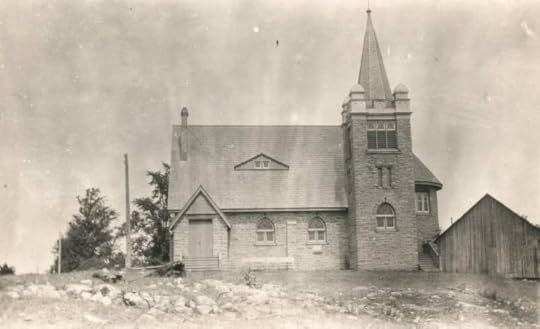
St. John’s Anglican Church in the early days

The church features a distinctive cross, illuminated in blue,
donated in memory of the James family.
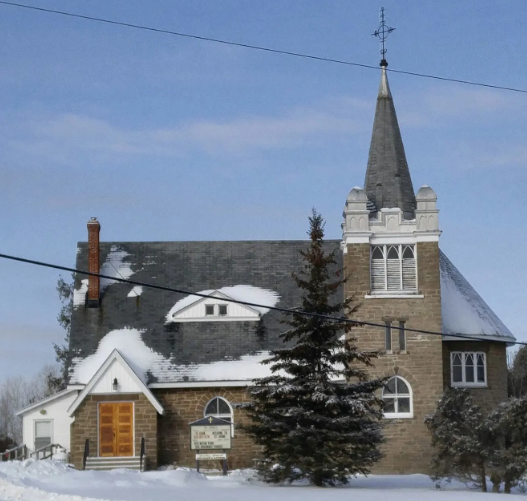
St. John’s Anglican Church, Innisville in modern times

Known as, “the little church with the blue cross”, St. John’s Anglican is located at 110 Fergusons Falls Road, at Highway 7, Lanark Highlands
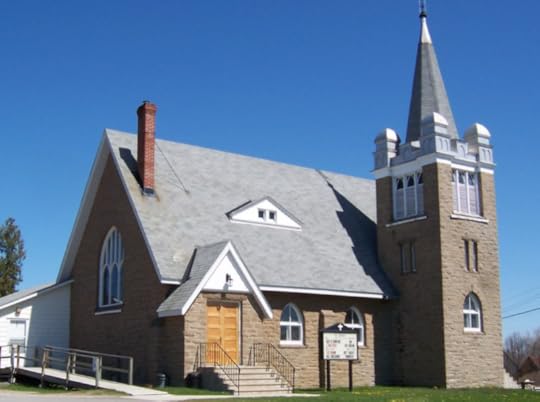
Women’s Guild
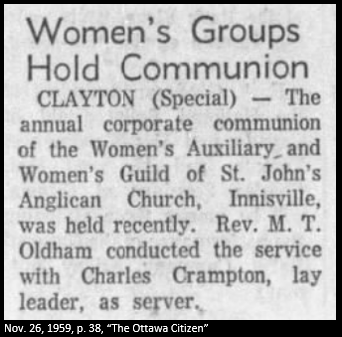
In 1959, the Women’s Auxiliary and Women’s Guild of St. John’s Anglican held their annual corporate communion. Rev. M.T. Oldham conducted the service and Charles Crampton was the lay-leader.

1962 Women’s Guild, President: Mrs. Norman Shannon, Vice-Presidents: Mrs. Norman Dowdall and Mrs. Gordon James, Secretary-Treasurer: Mrs. Wellington Weir
Officers – 1962
Harry Ireton, Clifford Gardiner, Winnifred Crampton, Mrs. Harry Ireton, Edward Rathwell, George Gardiner
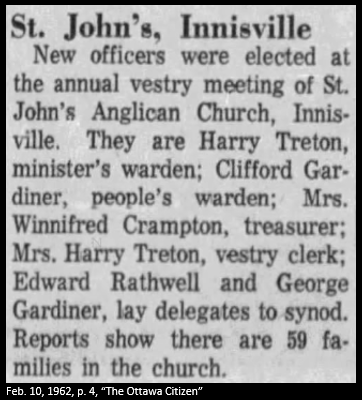
Officers – 1963
Clifford Gardiner, Harry Ireton, Mabel Gardiner, Winnifred Crampton, James Gardiner, Ed Rothwell, Gordon James and Joseph Chamney
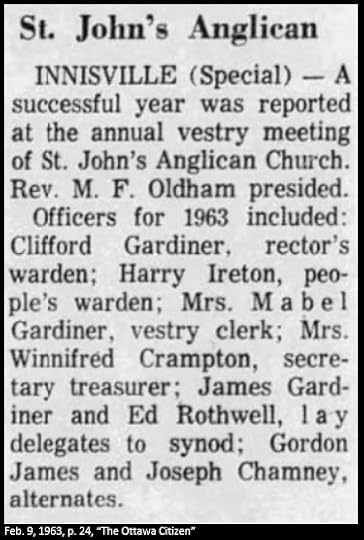
2012 – Rev. David Vavasour

Photo of Rev. David Vavasour: “Inside Ottawa Valley, Jan. 12, 2012
In 2012, Rev. David Vavasour took over the duties of the interim Rector, Rev. Laurette Glasgow. His predecessor in Innisville was Canada’s former Ambassador to Belgium.
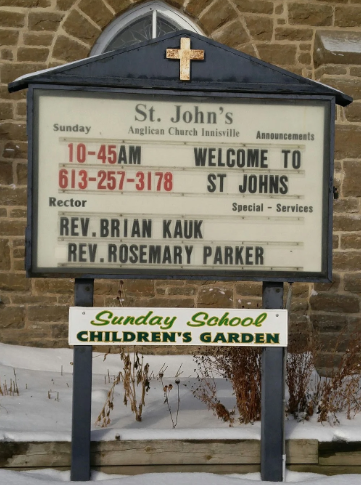
Rev. Brian Kauk and Rev. Rosemary Parker are the ministers for the parish in 2023, which includes St. John’s Anglican Church in Innisville. The Venerable Brian Kauk also serves as the Archdeacon of Lanark-Arnprior.

Rev. Brian Kauk – photo: Anglican Diocese
Church Closing
On January 22, 2023, an announcement was issued that St. John’s Anglican Church in Innisville would be closing:
“The motion to decide on the disestablishment of St. John’s Innisville carried unanimously at the Special Vestry called for that purpose on Sunday, January 22nd, 2023. We will no longer be holding services at St. John’s.
Please know that the congregation of St. John’s will always be welcome at any of the churches in our Parish of Mississippi Lake.
St. James Franktown, St. James Carleton Place, Christ Church Ashton and St. Bede’s Chapel.
We wish you well at this sad time.“
Some of the surnames of the St. John’s Congregation over the years: ARMSTRONG, BENNETT, BOWLAND, BRYDES, BURDON, CASWELL, CHAMNEY, CRAMPTON, DEZELL, DIAL, DOUGLAS, DOWDALL, DRYNAN, EBBS, GARDINER, GRAHAM, GRIFFITH, GUILLAM, HART, HOUSTON, IRETON, IVESON, JACKSON, JAMES, MCCALL, MCDOUGALL, MCKIM, MCVEETY, MORRIS, OLDHAM, PRESTON, RATHWELL, RICHARDSON, ROTHWELL, SHANNON, SHEPPARD, WEIR
Note: Church history and Records:
A parish history was published c1986.
The parish registers for this congregation are with the Parish of Clayton.
Cemetery Transcriptions:
St. John’s Anglican Cemetery, near Innisville : Lot 1, Concession 12, formerly the Township of Lanark, now part of Lanark Highlands, County of Lanark, Province of Ontario
Authors: Marion Cavanagh, Gary J. Byron, Lanark County Genealogical Society
Print Book, English, 2001
Edition: Updated
Publisher: Lanark County Genealogical Society, Perth, Ont., 2001
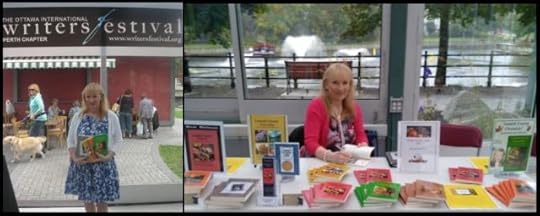
Arlene Stafford-Wilson
Member, Association of Professional Genealogists
Honorary Life Member, Lanark County Genealogical Society
Author of : “Lanark County Christmas”, “Lanark County Comfort”, “Lanark County Collection”, “Lanark County Calling”, “Lanark County Classics”, “Lanark County Connections”, “Lanark County Calendar”, “Lanark County Chronicle”, “Lanark County Kid”, & “Recipes & Recollections”
available at local stores or email: lanarkcountybooks@gmail.com
February 18, 2023
Farmer of the Week 1962-64

‘Farmer of the Week’ was a column that appeared in “The Perth Courier”, and ran from August 1962 until August 1964. The farmers featured in these articles were chosen because they were noteworthy. Some were prominent because of the sheer size of their operations, some were unique because of the type of farming they did, and some specialized in a style or method of farming that was deemed newsworthy at that time. No matter the reason that each of these local farmers was singled out, they were all important to our community. Many were members of community organizations, active in their churches, and some were even politicians. The most important thing they all had in common, and a source of pride for all, was that they were farmers…..
This is a tribute to our Lanark County farmers. Not all were featured in the local papers, but all contributed to their families, and their communities. We are grateful for those who labour in the soil, in all weather conditions, to put wholesome food on our nation’s tables. Thank-you!
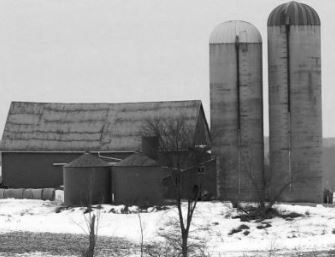


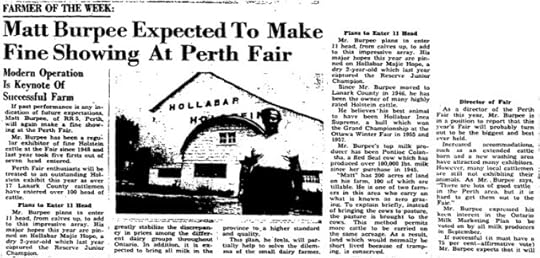
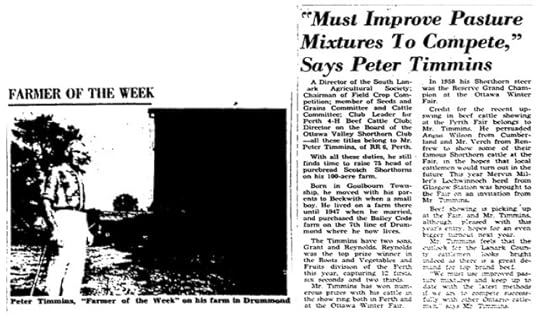
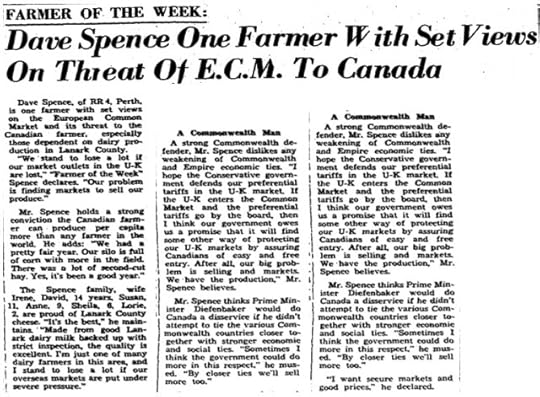

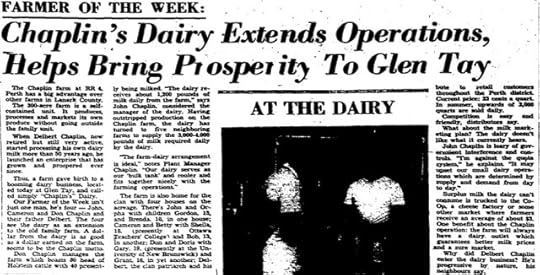
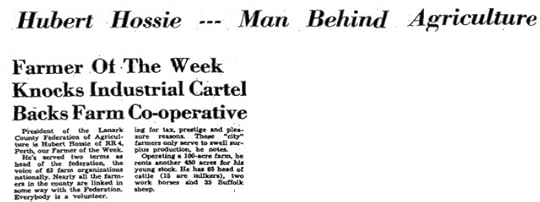

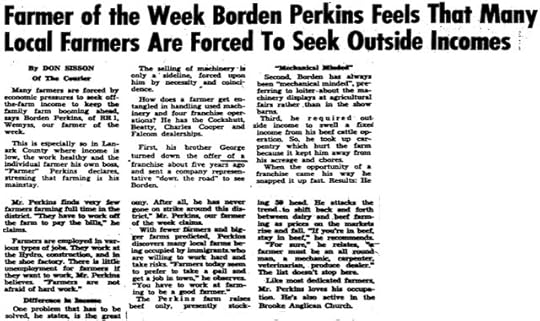
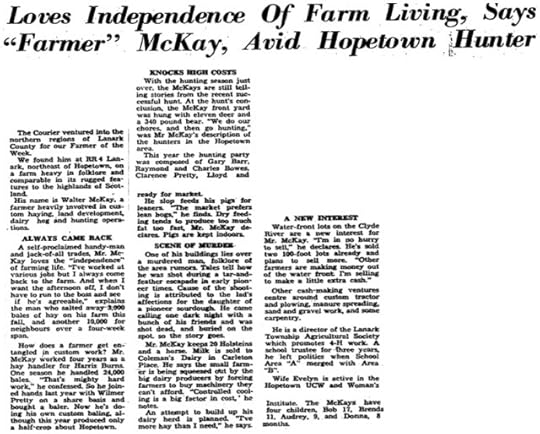
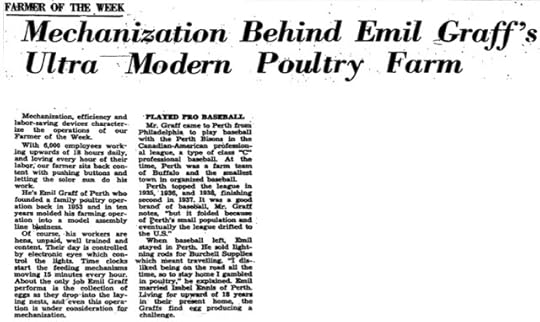
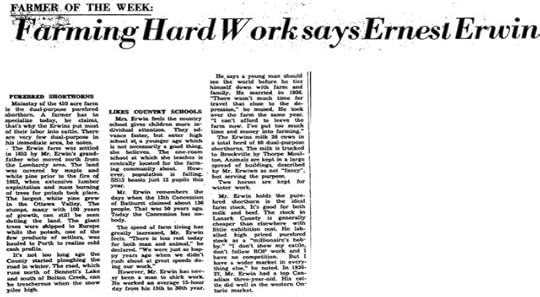
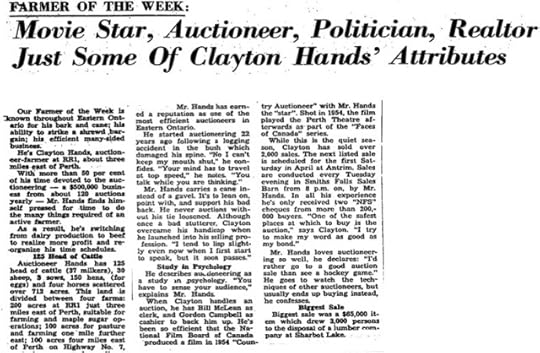
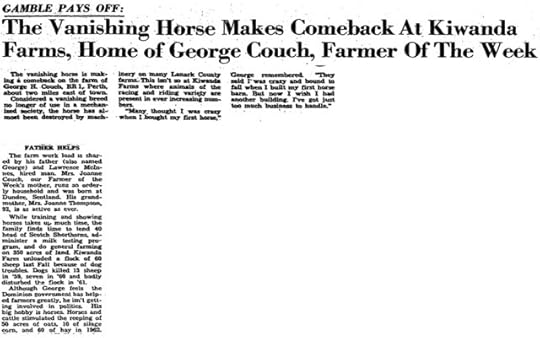
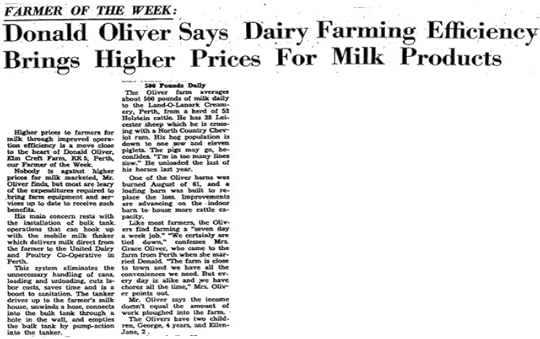
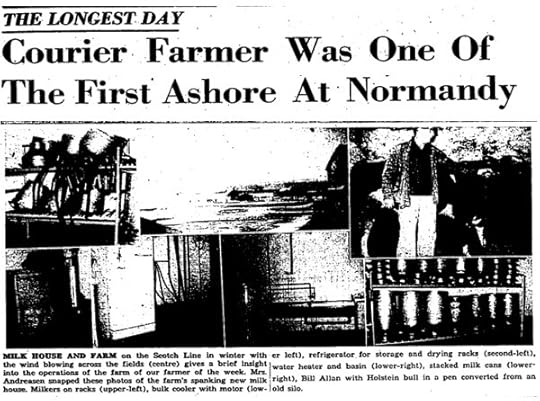

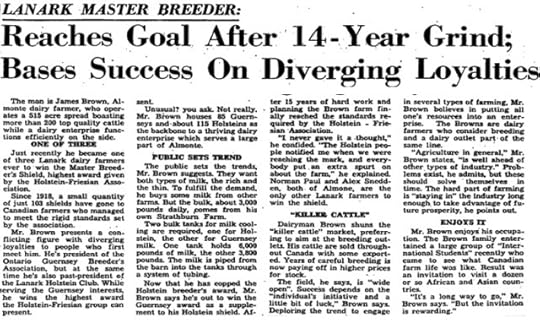
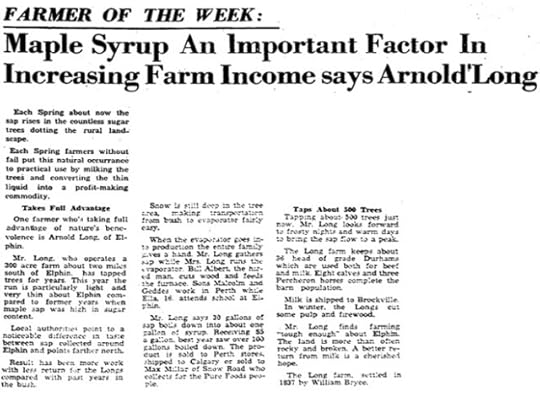
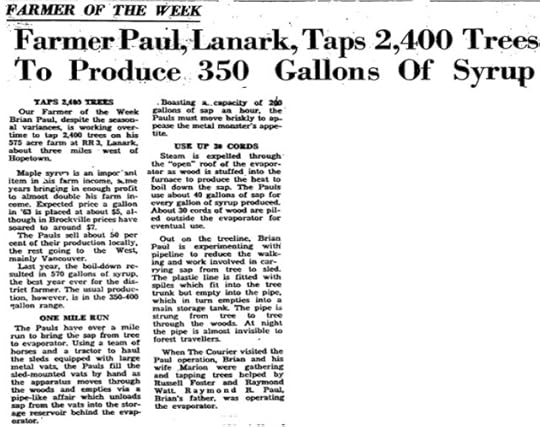
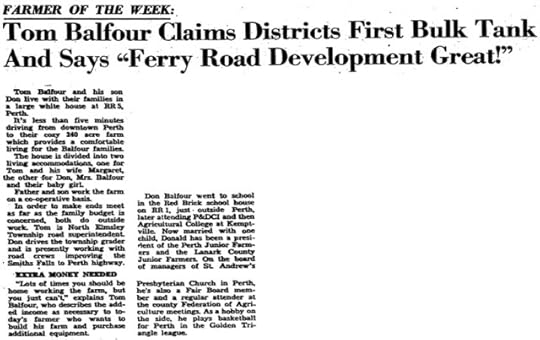

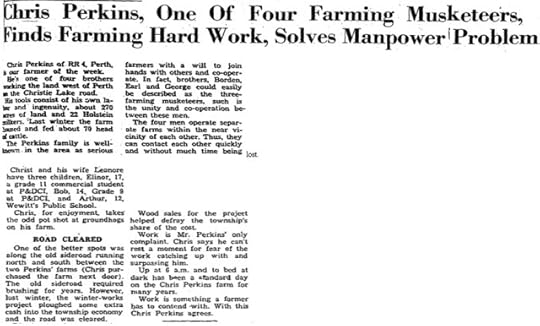
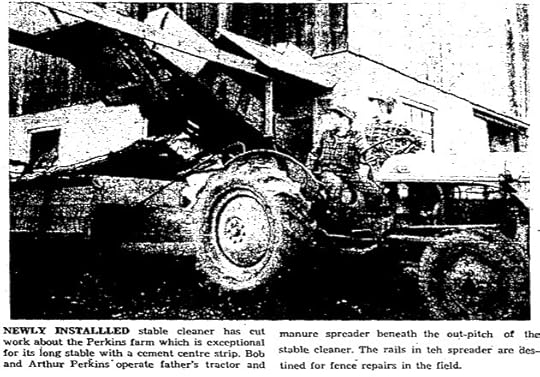

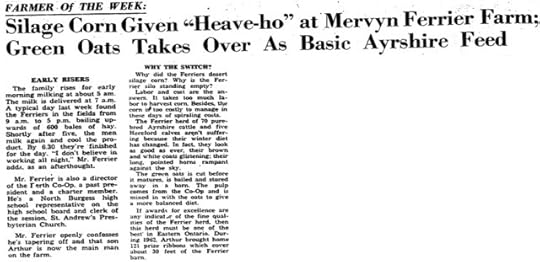
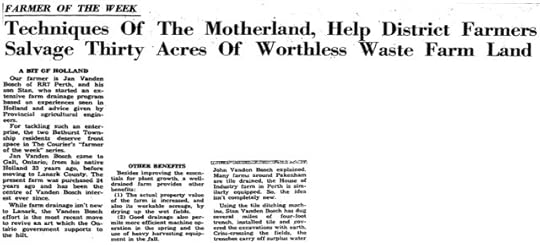


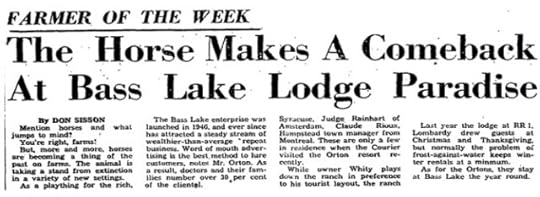

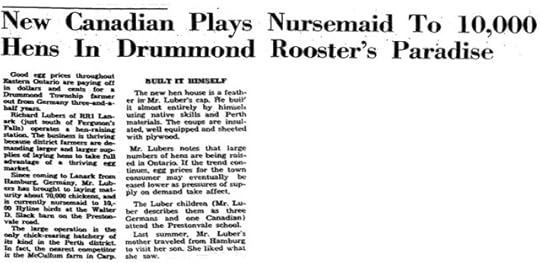
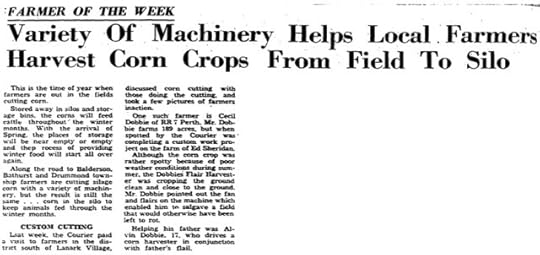
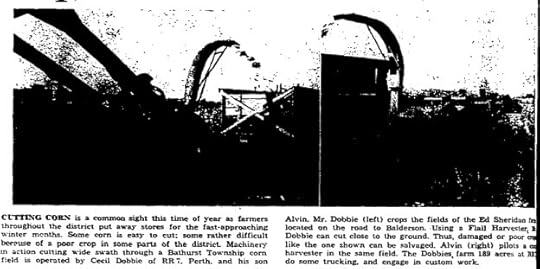
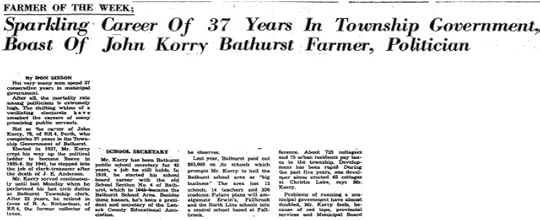
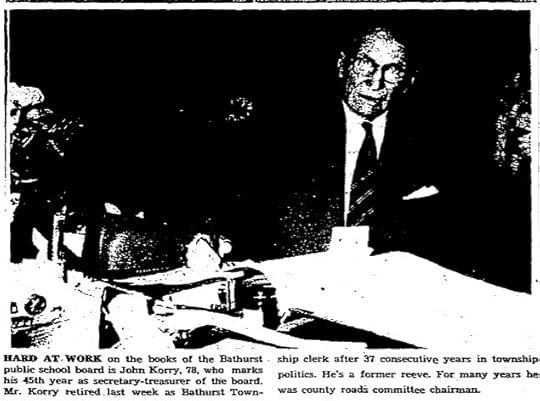
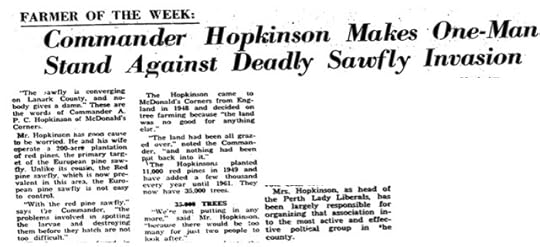

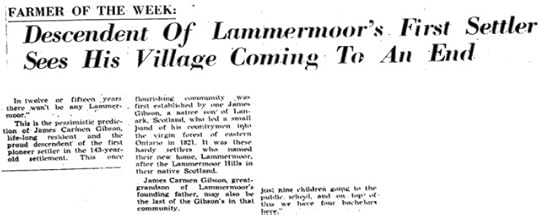
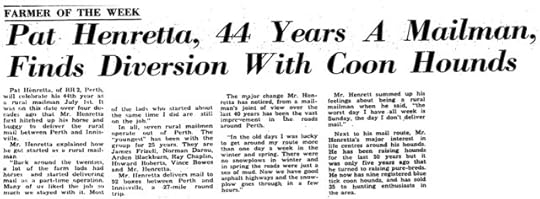

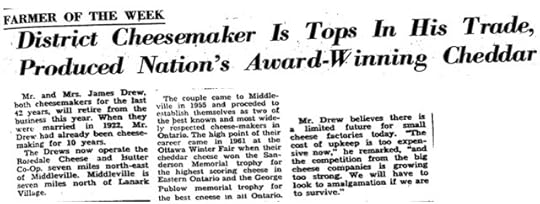

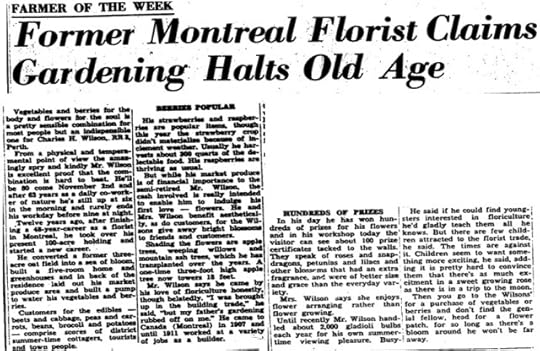
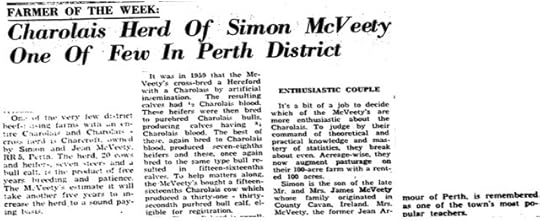
 This article is a tribute to our local farmers. They work long hours, in all kinds of weather, to provide meat, milk, fruits, vegetables, maple syrup, and bread, for our tables, and for this, I am truly grateful.
This article is a tribute to our local farmers. They work long hours, in all kinds of weather, to provide meat, milk, fruits, vegetables, maple syrup, and bread, for our tables, and for this, I am truly grateful.
Arlene Stafford-Wilson
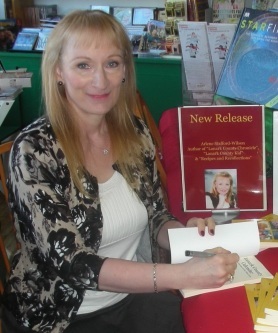
February 16, 2023
Maple Trailblazers: Founding Families of Lanark County’s Maple Legacy

Did you know that the very first Festival of the Maples was held in Perth, Ontario back in the 1970s?
The story that follows is dedicated to the Lanark County families who played such a significant role, back in the early days, leading up to this annual festival in Perth: Andrew and George Korry, Bowes family of Glen Tay, Ernie and Evelyn Miller family of Glen Tay, Robert McEwen of Prestonvale, Ken VanAlstine of Maberly, Leonard and Tom Adam of McDonald’s Corners, Brien and Marion Paul west of Hopetown, Lanark, James ‘Carman’ and Edna Gibson of Dalhousie Township, Don and Marion Dodds of Clayton, George Coutts of Rideau Ferry, Wheeler family of McDonald’s Corners, and Fulton family of Pakenham to name a few.
Taffy on the TayYears ago, many of the local farmers produced maple syrup. Some made just enough for their families, and for others it was a supplement to their farm income, at a time of year that was less busy, than during the summer months. There were also a few dealers in the area that sold sugar bush supplies – Max Miller of Snow Road, Percy Drysdale of McDonald’s Corners, and W.J. Ballantyne in Lanark. James Brothers Hardware and the Co-Op in the town of Perth also sold supplies for maple production. Labels for the bottles were often printed by ‘The Perth Courier’.
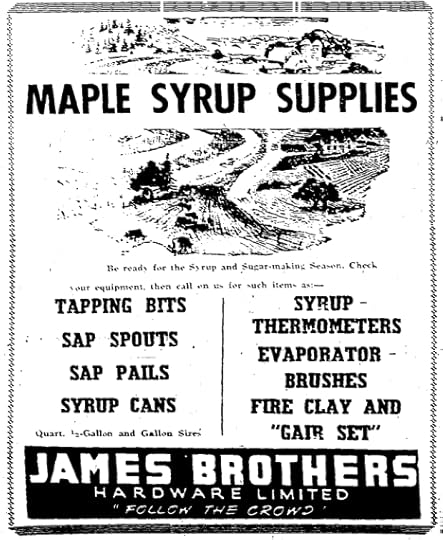
The Korry family farm was located across the road from our farm. They owned a medium sized sugar bush, and produced enough syrup to sell locally. Andrew Korry’s son-in-law John Chaplin sold it through his business – Chaplin’s Dairy, door to door, to their customers on the milk routes. Andrew and his son George were very busy for several weeks each spring making syrup, and my brother Tim Stafford worked with them in the bush one season. Extra help was always welcome. They used a team of horses, with a tank mounted on the sleigh, to draw the sap back to the evaporator, at the sugar shack; typical of many other producers at that time.
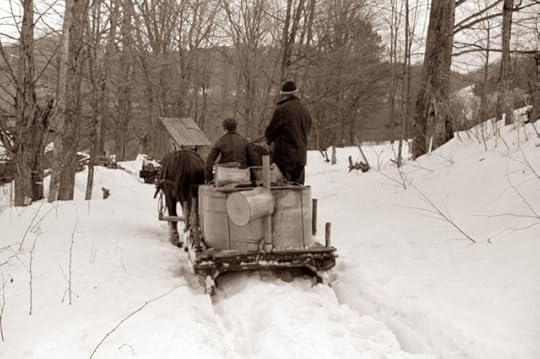
The Bowes and the Miller families of Glen Tay also produced their own syrup. I recall that Art Bowes used to tap quite a number of trees in the mid-sixties. Their land was known as Tayview farm, and it straddled the Tay River -a beautiful setting. At that time they had about 300 acres including hay fields, pastures, and of course maple bushes. Art’s son Doug traveled along with us on our school bus each day in the 1960s, and he often spoke about helping his Dad back in the bush each spring.
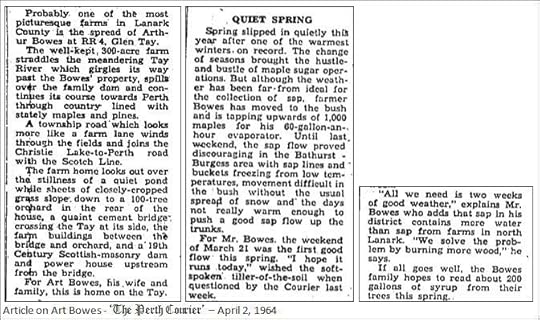

The Miller family’s farm, known as Tayside was owned by Ernest ‘Ernie’ Miller and his wife Evelyn (Mather). The Miller family arrived from Scotland in 1809, and their farm was purchased by Ernie’s great grandfather Dodds in 1858. Their kids were Diane, Nancy, John and Ruth. Evelyn was a lovely, soft-spoken lady, and she was my first 4H club leader. I also recall that Ernie was tapping about 1,500 trees back in the sixties, and had about 30 acres of maple woods. Ernie was a forward thinker, and one of his ideas at that time was that sap should be gathered by trucks from each farm, and taken to a large central evaporator – similar to the way that milk was trucked to cheese factories. It seemed through the years that Ernie was into everything. When he wasn’t farming he wrote history books, he researched genealogy, he worked with young people, and it was no surprise to me when he was inducted into the Ontario Agricultural Hall of Fame in 2003.

The McEwen clan in Ferguson Falls was another family who made their mark in the maple syrup business back in the 60s. In 1966 Robert McEwen of Prestonvale opened up the first pancake house in the area. Originally, Robert made his syrup the old fashioned way, out in the bush, and boiled a cauldron of sap over the fire. Later, in the 1970s I remember that he was one of the first to use plastic pipelines to bring the sap from the trees to one main location. Our Dad knew the McEwen family well, having grown up in that area, and said that Robert often spoke of the difficulties involved in syrup production. It was difficult to find reliable labour, and also challenging was finding the capital to purchase new equipment. Robert was very active in the local industry, and at one time was the President of the Lanark and District Maple Syrup Association.
When the former McEwen Sugar Shack went up for sale, Charles Temple and his wife Susan Snyder bought the property – the very first day it was on the market. The property known now as Temple’s Sugar Bush consists of 70 acres of maple bush where 5,000 trees are tapped annually.

…..
Ken VanAlstine in Maberly tapped over 2,000 trees when I was a kid, and he was among the first to use pipelines. He experimented at first, and tapped just 200 trees using the pipeline system, but the rest was collected in buckets, the traditional way, and transported to the evaporator by horse and sleigh.
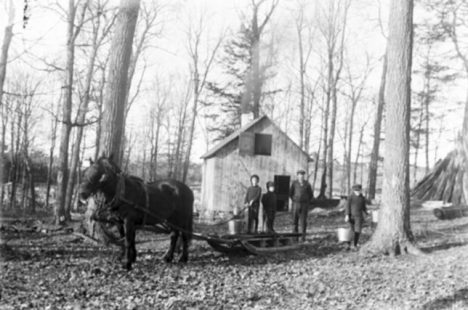
Ken, like other producers in the area, found the cost of hiring labour prohibitive, and found that distributors wanted too much money per gallon. Ken was well known in the area for his excellent quality maple syrup, and said on his best day at that time he gathered 3,300 gallons of sap.

…..
The Ennis family also has a long history of maple production. Their ancestor Arthur Ennis came from County Cavan, Ireland to Lanark County in 1840, and the family has been producing maple syrup for almost a century. Their sugar bush is located on the eastern shores of Bennett Lake, at the end of Ennis Road, Balderson, in Lanark County. Five generations of the Ennis family have been tapping trees on this property.

Another local family of long-time maple producers is the Adam family of McDonald’s Corners. Leonard Adam and his brother Tom tapped an average of 2,250 trees, and owned about 500 acres of land between them. They were hard workers, and spent many days sawing, chopping, and stacking the 20 cords of wood required for their evaporator. The Adam family were one of the first to use a brand new style of evaporator which was 4 by 14 feet. They produced enough to sell locally, and the remainder was shipped out West.
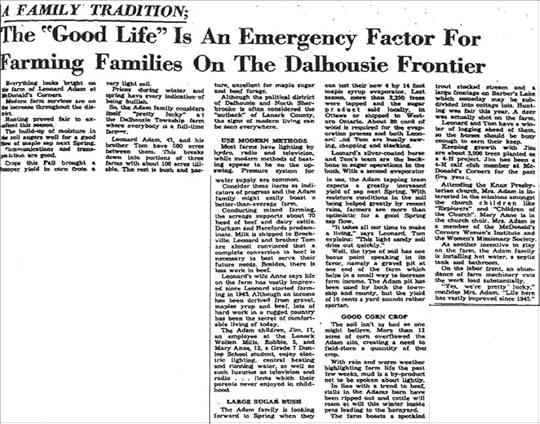
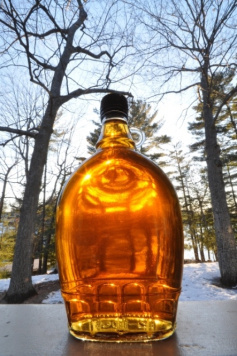
Brien and Marion (McLaren) Paul of R.R #3 Lanark owned a 575 acre farm, about three miles west of Hopetown, and began maple production in 1953. Marion was raised on a farm near the village of Lanark, was known locally as the ‘First Lady of Maple’, and served proudly as a Maple Judge at the Royal Winter Fair in Toronto. Their kids Kathy, Wayne and Darrell were also very involved in maple production, and provided additional labour for the family business. In 1972 Kathy was crowned Maple Queen in the local competition.
Back in the 1960s the Paul family used two sleighs, one pulled by a tractor, and the other by a team of horses. Brien’s father Raymond Paul often tended the evaporator, keeping a watchful eye as the sweet, fragrant, steam boiled off into the air. Russell Foster and Raymond Watt often assisted the Paul family with their production. They tapped an average of 4,000 trees at that time, produced about 700 gallons of syrup, and used approximately 30 cords of wood during the season.

The Paul’s were pioneers in the maple industry, and were very modern in their approach. They were one of the first to install plastic tubing, and an oil fired evaporator. The plastic pipes were attached to the tree spiles, and the sap flowed through the pipes, and emptied into a storage reservoir located behind the evaporator. Brien and Marion were inducted into the International Maple Hall of Fame, and were proud members of the Ontario Maple Producers and the Lanark and District Maple Producers Association.
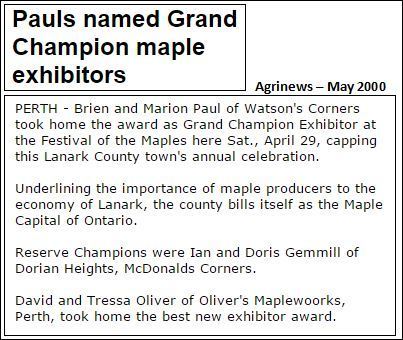
…..
Gibson was a name known for their excellent syrup. James ‘Carman’ Gibson, and his wife Edna (Rodger) had a maple business in Dalhousie Twp at R.R. # 4, Lanark. The nearby areas of Hoods and Poland were well known for their fine quality maple syrup. The Gibson family began tapping trees in 1821 with the arrival of James Gibson from Lanark, Scotland. He was the first pioneer settler in the area, and named their new home Lammermoor after the Lammermoor Hills in Scotland. Their five children Verna, Beatrice, Norma, Carol and Earl helped with the operation. The Gibson family also raised beef, dairy on their busy farm, and hauled milk to the Middleville cheese factory.
…..
When locals think of a long running maple operation, the name Dodds comes to mind. They had a substantial sugar bush at R.R. 2 Clayton, in the Lanark Highlands. The Dodds family has owned Springdale Farm for generations, producing maple syrup since 1917, and Don and Marion Dodds, and their sons Bryan and Stephen helped with production through the years. The family has won many awards for being long term maple producers, and Stephen Dodds won the Grand Champion Trophy at Perth Festival of the Maples in 2011. Their long, long, list of awards include trophies for World Champion Maple Syrup, Sugar Maker of the Year, and a memorable meeting with HRH Prince Charles at the Royal Winter Fair.

…..
One of the maple syrup families that I remember fondly was the Coutts family on the Rideau Ferry Road. I’ll never forget how George Coutts invited local kids to visit his sugar shack. He would take the time during the very busy season to patiently explain how the maple syrup was made. Miss Norma Devlin from the North Elmsley School was invited each year to bring her grade one class to visit the Coutts farm. George along with his son Kenneth showed the children how syrup was made and even provided the kids with some maple taffy at the end of the tour.
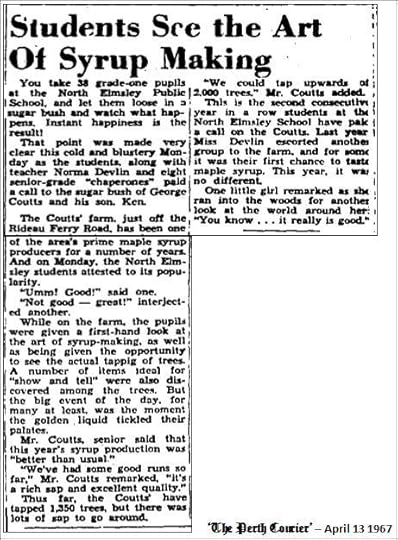
In the 1960s the Coutts family tapped about 1,300 trees yearly, and produced more than enough syrup for both the family and for area sales. Maple syrup was produced in the early 1900’s by Archibald Coutts. In 1920, George Coutts purchased an evaporator, and the production of maple syrup has continued ever since.
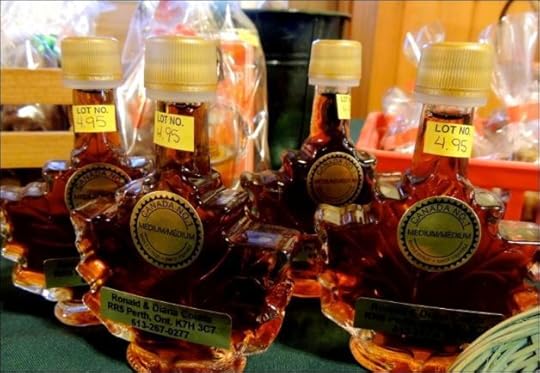
…
The ancestors of the Fulton family began to tap their maple trees back in the 1840s when John Fulton and his brothers came to Lanark County from East Kilbride, Scotland. Their large 370 acre farm is located between Almonte and Pakenham, and they have tapped their huge 4,000 tree sugar bush for many, many, generations. Well known for their high quality syrup they have also operated a pancake house for many years, and their sugar camp has been a popular attraction for both area families and visitors.

…
With these, and other long-time maple producers in Lanark County, it’s not surprising that back in the 1970s, there were lots of conversations, up and down the concessions, of hosting a maple festival in the town of Perth. It was Victor ‘Vic’ Lemieux, owner of Norvic Lodge, at Christie Lake, who first came up with the idea, and presented it to the Perth Chamber of Commerce. Thankfully, Vic was successful in his campaign to launch the first festival, with the hope that it would bring people out to celebrate the spring season, after a long, cold, winter.

On April 19, 1975 the very first Festival of the Maples was held in Perth and it was quite an event!
When my friends and I arrived at the very first Maple Festival that Saturday so long ago, part of Gore Street and Foster Street had been closed to traffic, and many local maple vendors had set up their displays. At 10 a.m. the Festival was officially opened by the Ontario Minister of Industry – Claude Bennett. The Perth Legion ladies, and the ladies from St. Andrew’s Presbyterian Church had displays of delicious home baking for sale, and there were also side-walk sales on Gore Street, and many arts and craft exhibits.
There were a tremendous number of district producers, and many of them offered syrup for sale in different grades, and various sized containers. Pancakes were available for purchase, and free samples of Balderson Cheese were available to anyone who asked, and I recall we went back a couple of times to that booth! One of the most unique displays was a wood-burning evaporator set up on one of the main streets of Perth. I’ve seen a few of those out in the bush, but I never thought I’d see one in town on the main street!
Fiddling and step-dancing competitions were held that day, and I recall Dawson Girdwood saying that some of the best fiddlers from Eastern Ontario were competing in the Open and Junior fiddling classes. The talented Jimmy Heney, one of our neighbours, won the fiddling prize hands down, as he often did, and Karen Grey of Perth was the top step-dancer that night.
The folks in Perth were always enthusiastic supporters of a beauty competition, and so part of the evening program, at the arena that night ,was the crowning of ‘The Sweetest Girl in Lanark County’. Miss Perth 1975 Michelle Hughes crowned the winner – Maple Queen – Susan Thompson, of Perth.
Over the years, we attended the Perth Maple Festival, and each spring it seemed to grow by leaps and bounds. Every year it seemed that there were more vendors selling their maple goods, more artisans displaying their crafts, and an increasing number of booths and displays. We also noticed a steady stream of tourists coming from Ottawa, Kingston, and even as far away as the States to visit our festival.

People in Lanark County, understandably, have always taken their maple syrup very seriously. Because of this, it was devastating to many when January of 1998 brought the most destructive ice storm in Canadian history. From January 4th to 10th Lanark County was severely affected by freezing rain, and ice pellets. Day after day it fell, and accumulated on tree branches, bending their limbs until they snapped off with the weight of the ice. The relentless freezing rain created a thick, heavy coat, damaging both the maple trees and the pipelines in the sugar bushes. Millions of tree branches were caked with the build-up of ice, and became so heavy that they split right off of the trees; severely affecting the sap flow. At the time, there were speculations that it might take forty years for maple production to return to normal.
Through hard work, and good fortune, many of the damaged trees came back, and the maple production resumed within a few years of the ice storm.
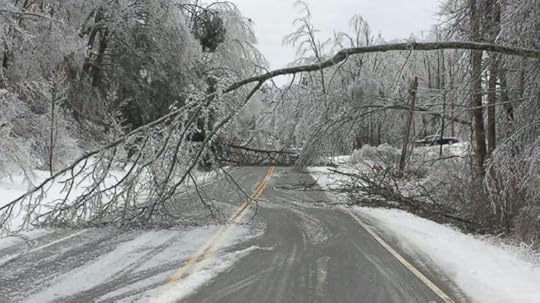
Many of us, raised in Lanark County, have participated in making maple syrup at one time or another, and know from experience that it’s extremely labour-intensive. We also have a clear understanding of the enormous amount of sap it takes to make a very small quantity of syrup. No matter how modern the equipment or methods, it still takes forty gallons of sap to make one gallon of syrup.

Now, add in the hours of labour for the tapping, transporting from the tree to the evaporator, the boiling down, the straining, the bottling, and the labeling. Next, factor in the cost of equipment such as the spiles, the pails or tubing, the evaporation tank, fuel, the straining equipment, the bottles, cans, and cost of transporting to market. The price per gallon really doesn’t sound like all that much anymore now, does it?
So, the next time you pass by the maple syrup display in your grocery store aisles, or visit a maple vendor at his farm, or at a festival, please remember how it’s produced.
Pause a moment, to remember the proud, hard-working, pioneer families who settled in Lanark County, and passed down their knowledge through the generations. Think of the enormous quantity of sap required to make a very small container of syrup. Most of all, please stop and consider the origin of your syrup, and take it from this Lanark County kid – you won’t find any better, more flavourful syrup, than from the Maple Syrup Capital of Ontario!
…………..
(The story above, “Taffy on the Tay” is an excerpt from “Lanark County Chronicle: Double-Back to the Third Line” )available at The Book Nook, and Spark Books in Perth, and Mill Street Books, Almonte
ISBN 978-0-9877026-2-3…
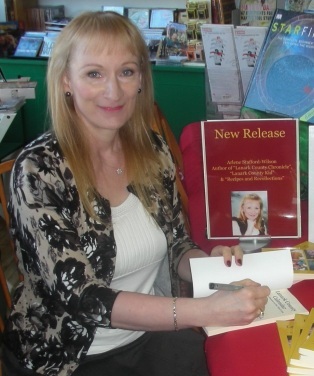
February 15, 2023
Hershey, Smiths Falls
1962-2008
The announcement of the Hershey Chocolate factory opening in Smiths Falls in 1962 brought a sense of hope and optimism to the town, with the promise of hundreds of unionized jobs, and attracting other new business and more tourism to the town.

Smiths Falls Water Tower

Grand Opening of Hershey Chocolate Corporation, attended by 3,000, April 17, 1961
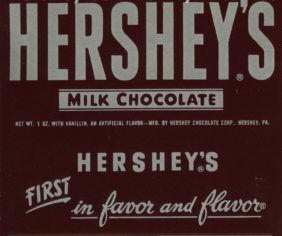
The style of the Hershey bar wrapper evolved over the years. The one above was used from 1951 – 1968.
In 1973 the company added nutrition-related information to their labels, and in 1976 they began to print UPC codes on their products.
In 1984 the white inner wrap was replaced with foil., and in 2003 the company switched to a one-piece wrap to maintain freshness.
(source: Hershey Archives)
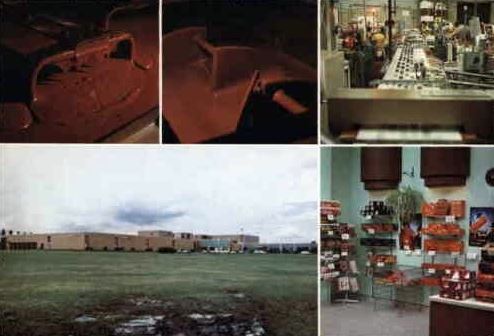
Post card featuring the Hershey Plant and Visitor’s Center in Smiths Falls – c. 1982

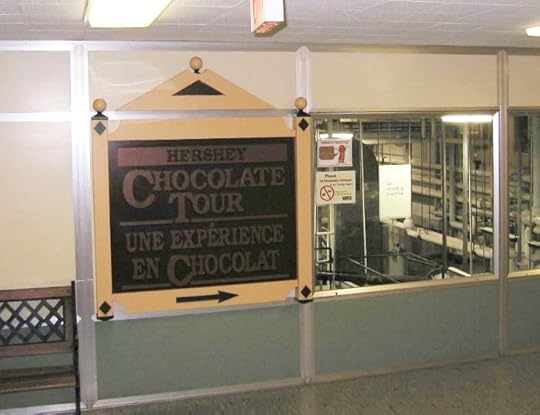
Where the tour of the chocolate factory began…

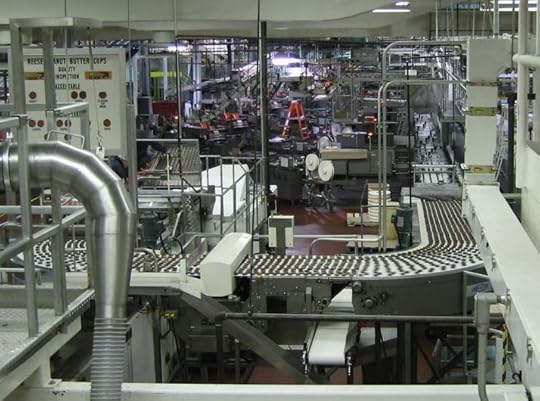
Chocolate travelling through the line at the Hershey factory in Smiths Falls

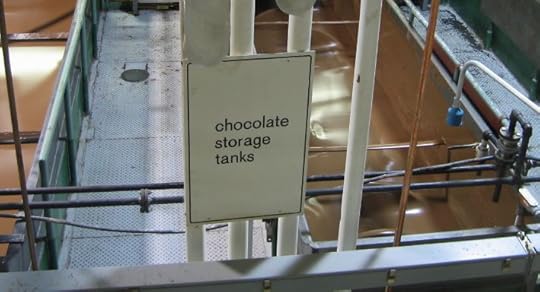
Enormous tanks filled with melted chocolate at the Hershey factory

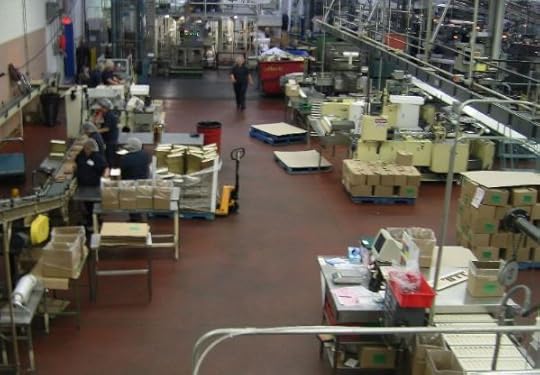
A view of the assembly line at the Hershey factory


Sign at the entrance to the Hershey Factory in Smiths Falls, Ontario
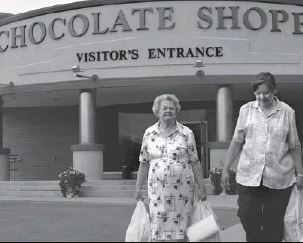

Hershey Closes
after 46 years
On February 15, 2007, Hershey Co., the parent company, based in Pennsylvania, announced that the factory would be closing as part of a re-structuring. Some jobs would be re-located to Mexico.
More than 650 employees were told that the closure was part of a company-wide supply-chain realignment.
According to local statistics, the enormously popular Chocolate Shop drew 425,000 visitors to the town in 2005.
Union spokesman, Harry Ghadban said, news of the closure was an “absolute shock.”
On December 23, 2008, production stopped, and the Hershey factory, and associated store were shut down.

Ad for Hershey Kisses


Although the Hershey plant is gone, many of us still have fond memories of visiting this very special place. The sights and sounds, and heavenly scents of this Smiths Falls gem will remain in our hearts and in our minds.
To discover more on the Hershey Factory:
“Sweet Sensation in Smiths Falls”,
one of the short stories in the book, “Lanark County Chronicle”

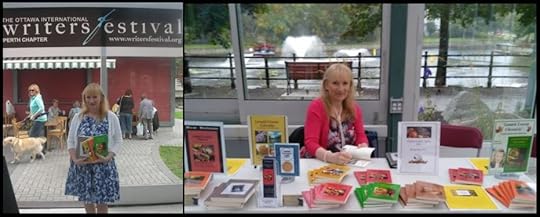
Arlene Stafford-Wilson
Member, Association of Professional Genealogists
Honorary Life Member, Lanark County Genealogical Society
Author of : “Lanark County Christmas”, “Lanark County Comfort”, “Lanark County Collection”, “Lanark County Calling”, “Lanark County Classics”, “Lanark County Connections”, “Lanark County Calendar”, “Lanark County Chronicle”, “Lanark County Kid”, & “Recipes & Recollections”
available at local stores or email: lanarkcountybooks@gmail.com
Carleton Place Old Days

First Known
as Morphy’s Falls
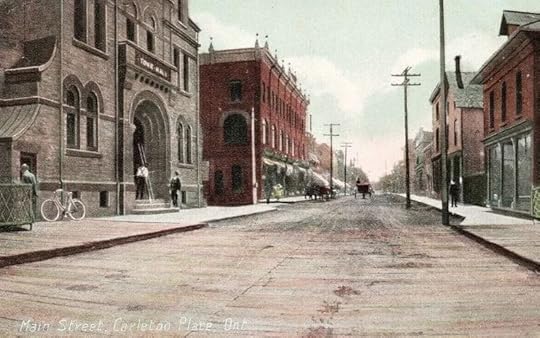
 July 14, 1928, p. 32, “The Ottawa Citizen”
July 14, 1928, p. 32, “The Ottawa Citizen”
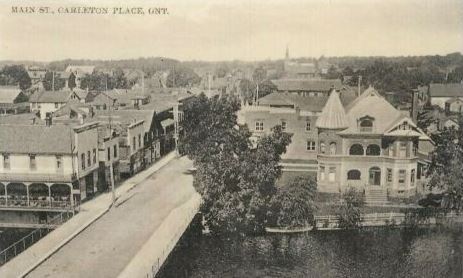
Town Hall
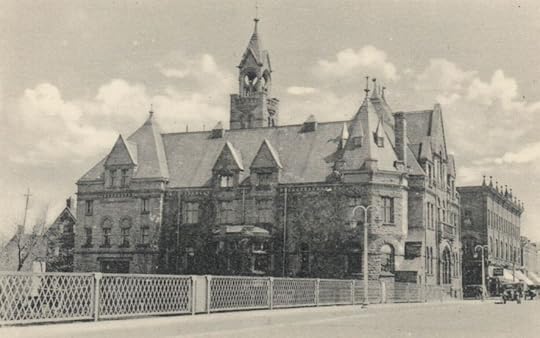
The town hall
was built in 1897
“Up to the year 1897, the town council met in a small building on the north side of the river, known as the old opera house.”
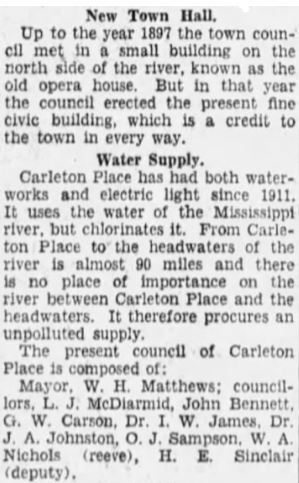
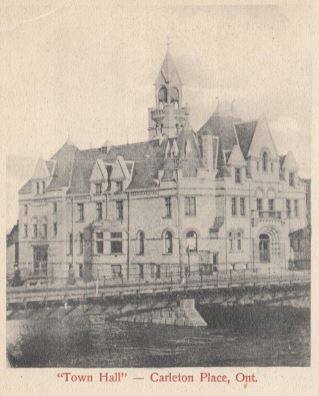
Findlay’s
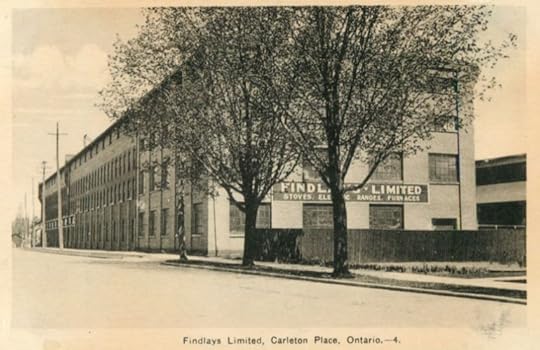
Main Street
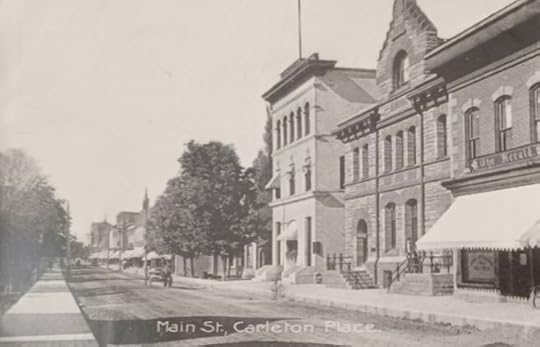
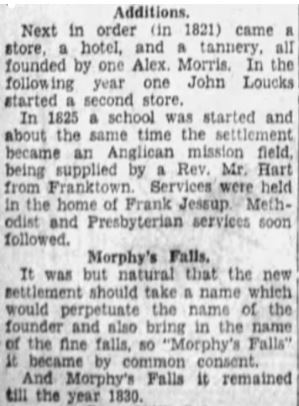
Methodist Church
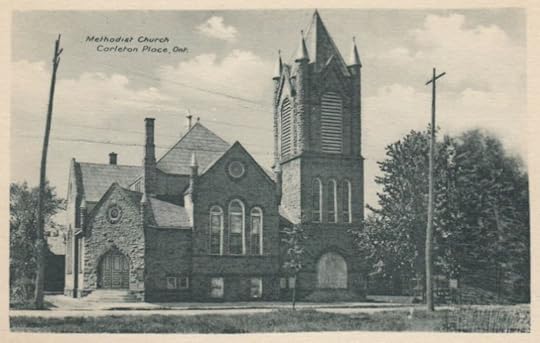
Carleton Place Methodist Church
“In 1830 a post office was first established and Caleb Bellows was the first Postmaster.”
Re-Named
“Nobody in Carleton Place at the present time (1928) can tell who gave the name Carleton Place…”
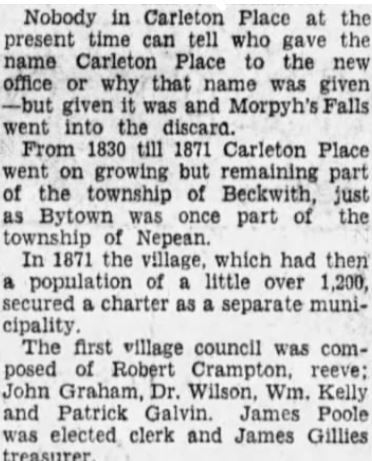
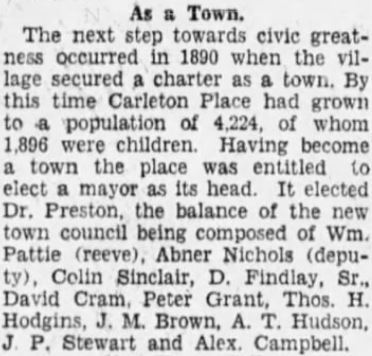
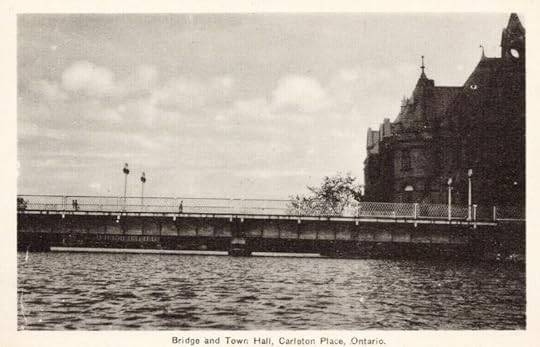
William Pattee
Opened New Bridge
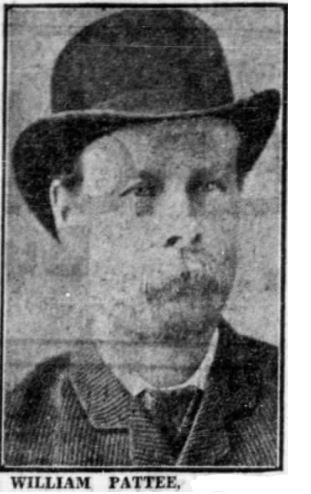
When the new ‘Central’ bridge opened in Carleton Place, in 1928, the honour of the official ‘opening of the bridge’ went to Carleton Place’s oldest citizen, 86 year old William Pattee.
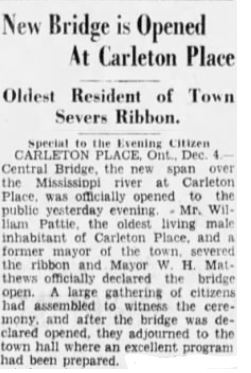
Dec. 5, 1928, p. 3, “The Ottawa Citizen”
Central Bridge
Under Construction
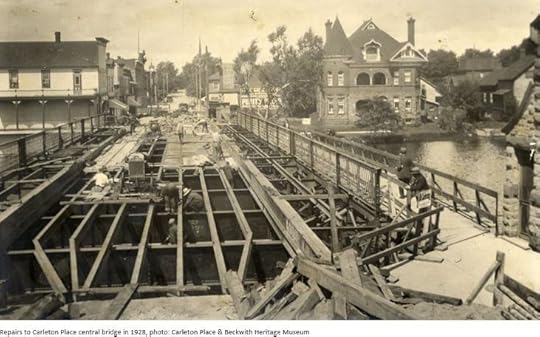
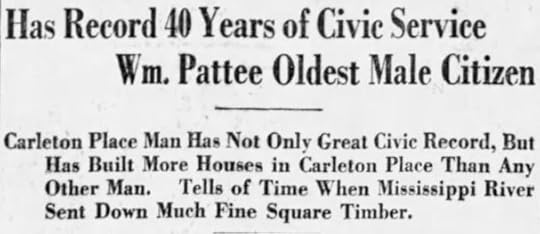

Carleton Place Orange Lodge – established in 1830, closed in 2015, after 185 years.
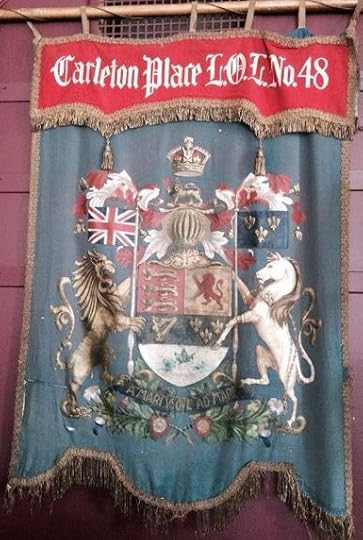
High School

Carleton Place High School – original building

Home of R. C. Patterson
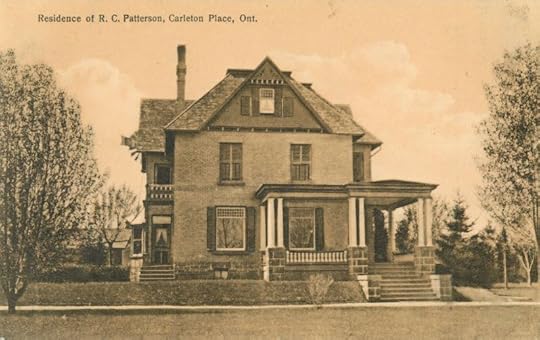
The Dam
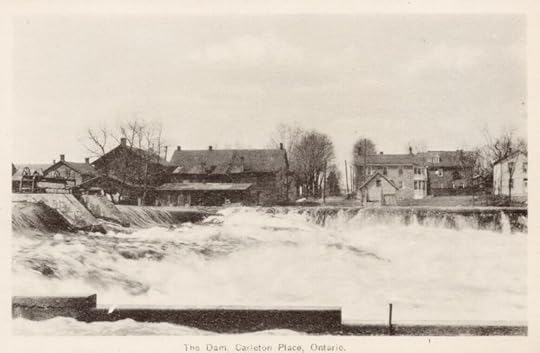
I hope you enjoyed our trip down memory lane,
in our visit to Carleton Place in the good old days!

Arlene Stafford-Wilson
Member, Association of Professional Genealogists
Honorary Life Member, Lanark County Genealogical Society
Author of : “Lanark County Christmas”, “Lanark County Comfort”, “Lanark County Collection”, “Lanark County Calling”, “Lanark County Classics”, “Lanark County Connections”, “Lanark County Calendar”, “Lanark County Chronicle”, “Lanark County Kid”, & “Recipes & Recollections”
available at local stores or email: lanarkcountybooks@gmail.com

